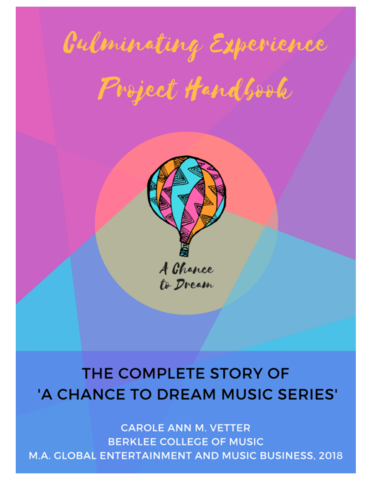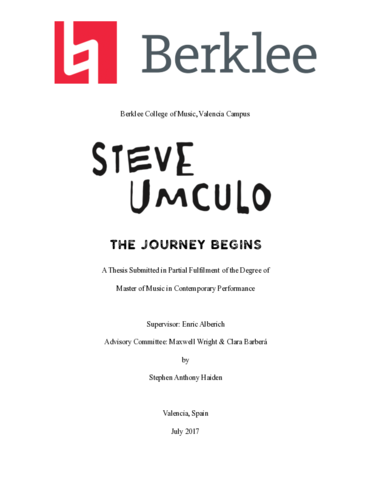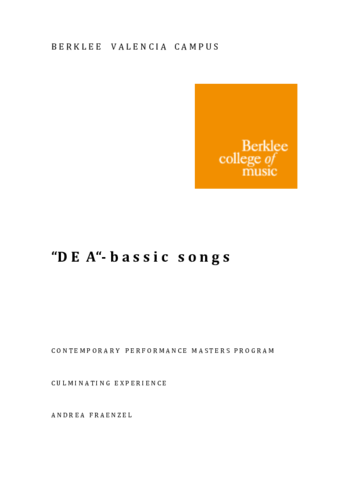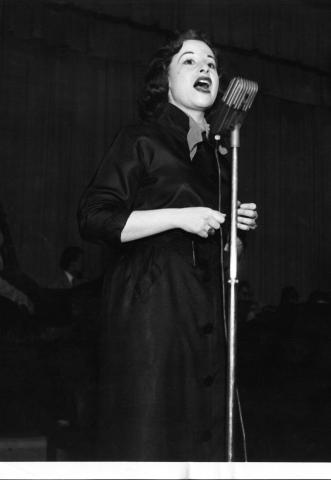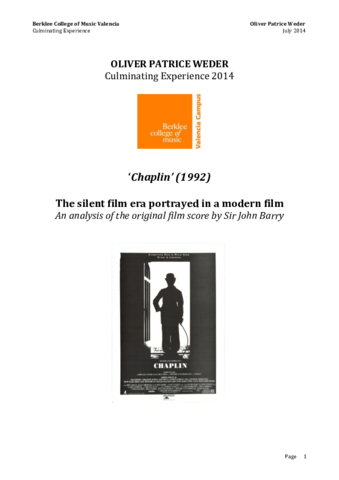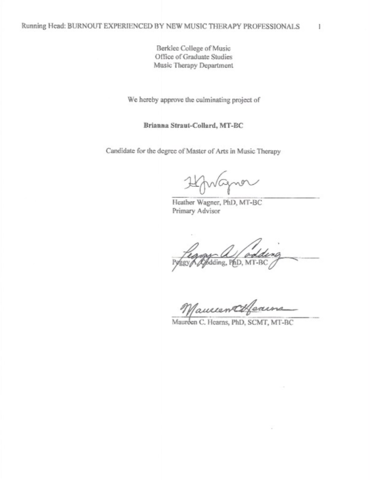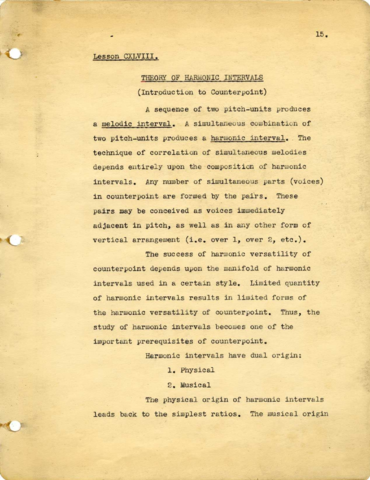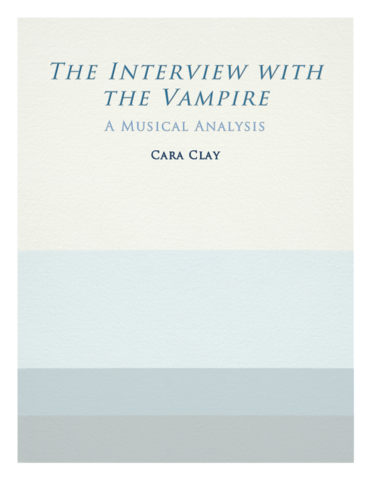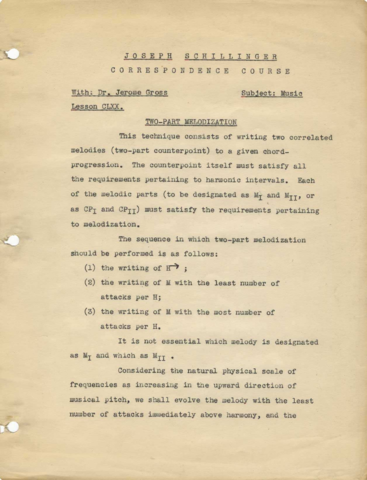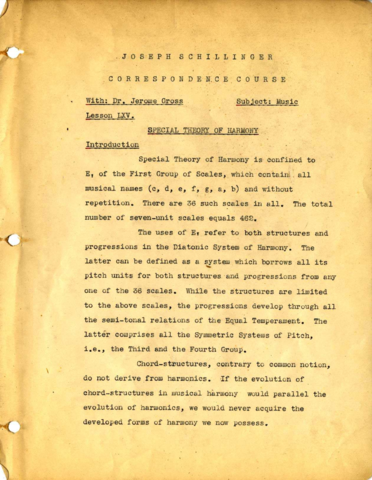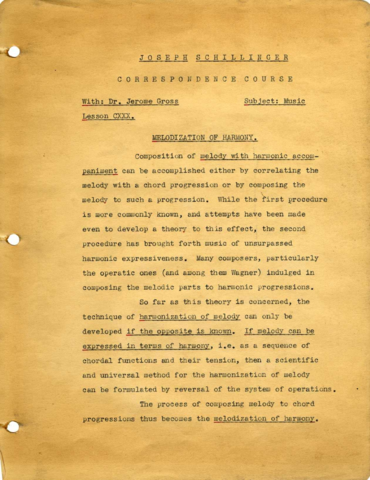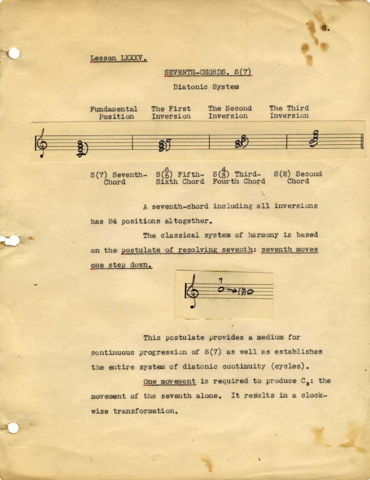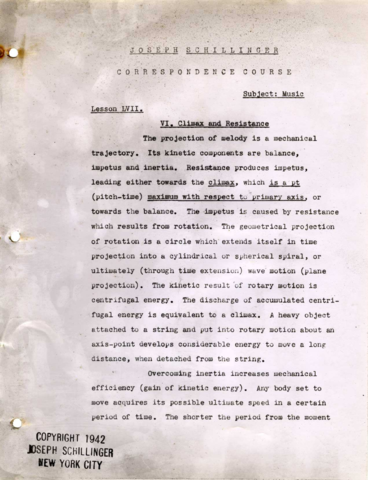Search Results
Displaying results 6451 - 6479 of 6479Correspondence between Dr. Gross & the Schillingers, discussing the course and Dr. Gross' progress. Other materials include an assignment on Instrumental Form, as well as a 1956 letter to Frances Schillinger from Bert Henry regarding proceeds paid to her from his Schillinger Center of Cleveland.
Correspondence between Bert Henry and Frances Schillinger regarding payments to use the Schillinger name, as well as his plans for the Schillinger Center of Cleveland, including its eventual dissolution and his decision to pursue a career in mathematics rather than music for financial reasons. Also includes exchanges between Mr. Henry and Stan Kenton regarding his student Roger Kiraly; and between Bert Henry and Carl Fischer.
I my CE thesis, I attempt to analyse the music from the motion picture "The Shawshank Redemption", trying to, on one hand, describe its narrative and emotional function in the film, answering to the question "why does it work?", and, on the other hand, justifying why this film was the founding work for the establishment of Thomas Newman's characteristic musical language, as a film composer.
What should a brazilian female singer and songwriter do to distinguish herself from the many other ones begin to release their albums now? What elements and tools should this composer and performer have in her music to be noticed? In what ways the formal training in a music college can improve the final result of this artistic work? In this culminating experience, those questions will be answered during the process of composing, arranging and recording five original songs, in brazilian styles. By understanding the profile of the brazilian female singer-songwriters, researching on their work and improving musical skills in performance, composition, improvisation and arranging, the result is becoming a full time singer and songwriter that is able to control all the phases in the production of an album: from pre-production (composing and arranging), to production (recording) and post-production (editing, mixing, mastering, releasing, publishing and performing).
A survey was undertaken in which 4,404 respondents participated to share their behavioral habits with regard to their interaction with music and its marketplace. Analysis of the responses was performed in order to discover relevant differences in behavior between those who identify as electronic music fans and those who identify as fans of other genres. Various behaviors were questioned in relation to listening habits, social media engagement, spending history, willingness to pay, and more. The data show that electronic music fans do behave differently from fans of other genres in a variety of respects (e.g. price expectations, music format preferences, and social media habits – among others). The data have the potential to be useful in aiding the development of business and marketing strategies for artists, record labels, and others by providing a more accurate view of the marketplace.
Off-air broadcast recordings of Schillinger House’s amateur talent competitions, Community Auditions and Tune Tryouts.
Produced in partnership with WBZ-TV, sponsored by Community Opticians (a Boston eyewear retailer), and hosted by Gene Jones and Vernon Williams, Community Auditions was one of New England’s highest-rated shows for years, airing from 1950 to 1986 (though Berklee’s involvement ended in the late sixties). Each week, Schillinger House faculty auditioned local talent, selected six acts to appear, and accompanied the acts on a live Sunday broadcast. Viewers voted for their favorite act by postcard.
In 1952, Lawrence Berk created a second talent competition, Tune Tryouts, in which amateur composers submitted original music to Schillinger House faculty, who then chose the top three songs (out of an average of 80 submissions per week) to be performed on the show. Viewers voted for their favorite song, an estimated 6,000 postcard ballots being received each week. Every fifth show, the previous four winners competed against each other. The show's regular vocalist was Schillinger House student Teddi King, who went on to experience commercial success in both jazz and pop.
These materials appear to be related to SSOMC Book VII (Theory of Counterpoint), Chapters 1-8, on the topic Art of the Fugue.
This project analyzes the function of the music for the movie Interview with the Vampire.
Seek is a pre-show live entertainment service that provokes users to use clues in order to find the location of a concert.
These materials appear to be related to SSOMC Book VII (Theory of Counterpoint). Topics include: two-part melodization & harmonization; harmonic and contrapuntal ostinato.
These materials appear to be related to SSOMC Book V (Special Theory of Harmony), Part I, Chapter 1 (Diatonic) and Chapter 6 (Passing 6/4).
These materials appear to be related to SSOMC Book VI (The Correlation of Harmony and Melody) in full.
These materials appear to be related to Part II of SSOMC Book V (Special Theory of Harmony), particularly Chapter 9 (Seventh Chords).
These materials appear to be related to SSOMC Book IV (Theory of Melody), Chapter 4 (Climax & Resistance).
- 6479 results found
Creator
-
Berklee College of Music
-
Zoe Schneider
-
Carolina Araoz
-
Christopher Weigers
-
Davis West
-
Jerzy Maczynski
-
Benjamin Jephta
-
Bret Ewen
-
Christopher Black
-
Joshua Harris
-
Luke Norris
-
Malwina Masternak
-
Mohammad Keivan
-
Aditya Srinivasan Maruthuvakudi Thiagarajan
-
Alan Tishk
-
Alexander Johnson
-
Alexey Leon Reyes
-
Audrey Cousineau
-
Camila Anino
-
Carlos Llerena Tolmos
-
Cassandra Allen
-
Chiara Michieletto
-
Connor Kent
-
Davide Lo Cascio
-
Djudju Hartono
-
Hannah Lebel
-
Himel, Megan
-
Hosanna Jireh Calo
-
James Connor
-
Jasmine Shepard
-
Jodie Michael
-
Luis Maria Regidor Pain
-
Melissa Caton
-
Michael Gelberg
-
MIGUEL RUIZ SANTOS
-
Misty Jones
-
Nicholas Zeigler-Heil
-
Nicolas Guerrero
-
Nicole Casino
-
Nicole Otero
-
Patrick Graney
-
Peter Anthony Connolly
-
Piotr Orzechowski
-
Reflection Paper
-
Ricardo Curto Garcia
-
Scott Peters
-
Simon Tomas
-
Stephanie Piedrahita
-
Timothy Shull Jr
-
Trevy Kiy
-
Tyler Sasso
-
Yu Lu
-
Aalap Deboor
-
Aaron Gatlin - Reflection Paper
-
Aaron Ramsey
-
Abigail Robinson
-
Alasdair McLeod
-
Alayna Hughes
-
Alejandra Menéndez
-
Alessandro Mastroianni
-
Alexander Foing
-
Alexander Palmer
-
Alexandra Morancy
-
Alicia Drexel
-
Alisdair McLeod
-
Amy Di Nino
-
Andrea Fraenzel
-
Andrés Rodríguez
-
Ankie Titulaer
-
Annelise Rivera Rivero
-
Anže Rozman
-
Austin Har
-
Benjamin Burrell-Plant
-
Berklee
-
Bernarda Ubidia
-
Beth Schofield
-
Bianca Johnson
-
Brianna Straut-Collard
-
Calen Mims
-
Cara Clay
-
Celia Rivero Santana
-
CE Paper
-
Chase Morrin
-
Chin Hsuan Liu
-
Christopher B. Weigers
-
Christopher Pohl
-
Connor Moen
-
Cristina Domínguez
-
Cristina Nadal
-
CV
-
Dana Fakhoury
-
Danel Illarramendi
-
Danel Illarramendi - Reflective Paper
-
Daniel Gadd
-
Daniel Hwang
-
Drew Redman
-
Erin Seibert
-
Eve Matin
-
Felipe Saalfeld Becerra - Reflective Paper
-
Felix Mayr-Melnhof-Saurau
-
Gabrielle Banks
-
Gerami Greer Groover
-
Gianni Abbott - Paper
-
Haojun Qi
-
Hillel Teplitzki
-
How to Use Digital Currency
-
Jacopo Mezzanotti
-
James Morris
-
Jared Horne
-
Jesse Pieter Boere
-
Jing Zhang
-
João Bruno Soeiro
-
John Broaddus
-
John Moses
-
Jonathan O'Hara
-
Jong Ho Choi
-
José Daniel Toledo Cajiao
-
Jose Soto
-
José Vargas
-
Joshua Porter
-
Juancristobal Aliaga Jorquera
-
Justin Angel Rivera
-
Kelsey Joanne Rogers
-
Kimberly Ellwanger
-
korina Davis
-
Kyle Bagley
-
Kyle Bagley - Reflective Paper
-
Kyrie Rolle
-
Lawrence Lee
-
Luiza Sales Rangel
-
Lyncia Pivert
-
Marcelo Wilson
-
Marco Chiavetta
-
Mark Martínez
-
Matej Zak - Reflective Paper
-
Matthew Capone
-
Matthew Mazzone
-
Maxwell Wright
-
Michael Sean Harris
-
Miguel De La Rosa Hernandez
-
Neda Shahram
-
Nicholas Esposito
-
Nikolaos Paterakis
-
Noé Zagroun
-
Obadiah Brown-Beach
-
Oliver Weder
-
Oscar De Lara
-
Oscar Lundberg
-
Outcome Paper
-
Pierluigi Barberis
-
Randle Thompson
-
Randy Schroeder
-
Rebal Alkhodari
-
Richard Wade
-
Ryan Renteria
-
Samuel Pisano
-
Sean Ruiz
-
Seneca Block
-
Seo Hyun Kim
-
Sergio Martin
-
Sergio Martínez Díaz
-
Stephanie Platzer
-
Stephen Haiden
-
Stephen McHale
-
Tanya Nath
-
Tess Stabb
-
The Jazz Symphony Orchestra
-
Thesis
-
Timotej Kotnik
-
Tomas Santibanez Bustos
-
Vanessa Martínez
-
Victor Josse
-
Vincent Williams
-
Wai-Yi Wong
-
Wesley A'harrah - Reflective Paper
-
What Tune Does the Bluebird Sing? A Cross-Genre Examination of Twitter Usage
-
Will Clark
-
Yohahn Jo
-
Zevik Perry
-
Zhang Siyuan
Date Issued
-
1997-04-25
-
1959
-
1987-05-04
-
1987-12-03
-
1988-04-28
-
1990-08-02
-
1992-04-14
-
1994-04-27
-
1995-04-26
-
1996-04-25
-
1997-04-23
-
1998-03-31
-
2000-12-12
-
2004-08-05
-
2005-02-14
-
2014-04-29
-
1958
-
1960
-
1962
-
1963
-
1964
-
1965
-
1966
-
1967
-
1970
-
1976~
-
1978-10-11
-
1979-09-24
-
1979-10-18
-
1984-03-15
-
1986-12-08
-
1986-12-10
-
1986-12-11
-
1986-12-12
-
1987-04-28
-
1987-05-08
-
1987-12-10
-
1988-02-04
-
1988-04-19
-
1988-04-27
-
1988-05-05
-
1988-10-11
-
1988-12-02
-
1988-12-05
-
1988-12-13
-
1989-04-20
-
1989-04-25
-
1989-05-03
-
1989-05-11
-
1989-11-17
-
1989-11-20
-
1989-12-04
-
1990-11-27
-
1991-04-01
-
1991-04-02
-
1991-04-03
-
1991-04-08
-
1991-04-10
-
1991-04-11
-
1991-11-19
-
1991-12-12
-
1992-04-02
-
1992-04-28
-
1992-05-06
-
1992-07-27
-
1992-12-04
-
1992-12-14
-
1993-08-02
-
1993-12-03
-
1993-12-06
-
1994-04-12
-
1994-04-19
-
1994-04-20
-
1994-04-21
-
1994-04-22
-
1994-04-25
-
1994-04-29
-
1994-05-05
-
1994-10-01
-
1994-12-20
-
1995-05-05
-
1995-12-14
-
1996-04-19
-
1996-05-02
-
1996-08-08
-
1996-08-12
-
1997-04-08
-
1997-04-09
-
1997-04-28
-
1997-11-14
-
1998-07-16
-
1998-07-28
-
1999-03-29
-
1999-03-31
-
1999-04-29
-
1999-08-04
-
2000-05-04
-
2001-01-31
-
2001-10-26
-
2001-12-05
-
2004-03-23
-
2004-04-02
-
2004-04-22
-
2004-04-27
-
2004-11-17
-
2004-11-30
-
2004-12-01
-
2005-03-22
-
2005-04-28
-
2006-04-04
-
2006-04-13
-
2006-04-18
-
2006-04-19
-
2006-05-02
-
2006-05-03
-
2006-05-04
-
2008-01-01
-
2009-01-01
-
2010-01-01
-
2010-03-26
-
2010-05-04
-
2011-01-01
-
2012-01-01
-
2013-05-07
-
2014-05-02
-
2014-07-31
-
2015-02-10
-
2015-02-11
-
2015-07-28
-
2015-07-30
-
2015-07-31
-
2017-02-14
-
2019-08-02
-
1961
-
1961~
-
1972
-
1973
-
1975
-
1976-10-15
-
1976-10-19
-
1976-11-16
-
1976-12-01
-
1976-12-06
-
1976-12-08
-
1976-12-10
-
1976-12-21
-
1977-03-25
-
1977-03-28
-
1977-03-31
-
1977-04-05
-
1977-04-14
-
1977-04-18
-
1977-04-20
-
1977-08-09
-
1977-08-17
-
1977-10-22
-
1977-11-21
-
1978-03-23
-
1978-07-19
-
1978-08-11
-
1978-09-26
-
1978-10-18
-
1978-11-21
-
1979-02-26
-
1979-04-03
-
1979-04-11
-
1979-07-18
-
1979-08-16
-
1979-10-26
-
1979-11-15
-
1980-02-26
-
1980-05-16
-
1980-07-18
-
1980-08-20
-
1980-11-18
-
1980-12-02
-
1980-12-03
-
1981-01-01
-
1981-03-25
-
1981-05-12
-
1981-06-02
-
1981-09-22
-
1981-10-26
-
1981-11-17
-
1981-12-07
-
1981-12-14
-
1982-01-21
-
1982-04-14
-
1982-04-15
-
1982-04-22
-
1982-04-29
-
1982-09-29
-
1982-10-15
-
1982-11-18
-
1982-11-30
-
1983-02-02
-
1983-02-15
-
1983-02-28
-
1983-03-01
-
1983-03-08
-
1983-04-06
-
1983-04-20
-
1983-04-21
-
1983-04-26
-
1983-04-27
-
1983-07-07
-
1983-07-20
-
1983-11-17
-
1984-02-22
-
1984-02-29
-
1984-03-26
-
1984-03-30
-
1984-04-13
-
1984-04-19
-
1984-04-25
-
1984-05-16
-
1984-07-11
-
1984-07-25
-
1984-08-15
-
1984-10-26
-
1984-11-01
-
1984-11-13
-
1984-11-14
-
1984-11-16
-
1984-12-11
-
1985-01-30
-
1985-02-06
-
1985-02-11
-
1985-04-09
-
1985-05-02
-
1985-05-09
-
1985-07-16
-
1985-07-18
-
1985-07-23
-
1985-07-24
-
1985-10-03
-
1985-10-25
-
1985-10-29
-
1985-11-19
-
1985-11-21
-
1986-04-08
-
1986-04-09
-
1986-04-16
-
1986-04-22
-
1986-05-06
-
1986-05-09
-
1986-08-05
-
1986-08-06
-
1986-08-07
-
1986-08-14
-
1986-10-21
-
1986-11-04
-
1986-11-07
-
1986-11-12
-
1986-11-18
-
1986-11-24
-
1986-12-01
-
1986-12-15
-
1987-02-03
-
1987-02-05
-
1987-03-24
-
1987-03-26
-
1987-04-17
-
1987-04-21
-
1987-04-29
-
1987-05-01
-
1987-05-07
-
1987-07-13
-
1987-07-28
-
1987-08-11
-
1987-08-19
-
1987-09-10
-
1987-09-11
-
1987-11-17
-
1987-11-30
-
1987-12-01
-
1987-12-02
-
1987-12-04
-
1987-12-07
-
1987-12-08
-
1988-01-28
-
1988-02-18
-
1988-02-23
-
1988-03-04
-
1988-03-07
-
1988-04-05
-
1988-04-14
-
1988-04-25
-
1988-04-29
-
1988-05-02
-
1988-05-06
-
1988-06-21
-
1988-07-27
-
1988-08-08
-
1988-08-10
-
1988-09-19
-
1988-10-04
-
1988-10-26
-
1988-12-01
-
1988-12-07
-
1988-12-14
-
1989-02-09
-
1989-04-04
-
1989-04-24
-
1989-04-26
-
1989-04-27
-
1989-05-02
-
1989-05-04
-
1989-06-01
-
1989-06-08
-
1989-06-13
-
1989-07-27
-
1989-08-14
-
1989-10-01
-
1989-10-16
-
1989-10-23
-
1989-10-30
-
1989-11-14
-
1989-11-27
-
1989-11-30
-
1989-12-01
-
1989-12-12
-
1989-12-14
-
1990-01-01
-
1990-02-26
-
1990-04-02
-
1990-04-04
-
1990-04-05
-
1990-04-09
-
1990-04-10
-
1990-04-11
-
1990-04-13
-
1990-04-17
-
1990-04-18
-
1990-04-23
-
1990-04-26
-
1990-05-02
-
1990-05-03
-
1990-05-08
-
1990-05-10
-
1990-06-01
-
1990-07-17
-
1990-07-25
-
1990-07-27
-
1990-07-30
-
1990-07-31
-
1990-08-03
-
1990-10-01
-
1990-10-26
-
1990-11-06
-
1990-11-14
-
1990-11-26
-
1990-11-28
-
1990-12-02
-
1990-12-07
-
1990-12-12
-
1990-12-13
-
1990-12-14
-
1990-12-20
-
1991-01-01
-
1991-02-19
-
1991-02-26
-
1991-03-05
-
1991-04-05
-
1991-04-09
-
1991-04-12
-
1991-04-22
-
1991-04-23
-
1991-04-24
-
1991-04-26
-
1991-05-01
-
1991-05-09
-
1991-06-01
-
1991-07-24
-
1991-08-13
-
1991-10-01
-
1991-10-07
-
1991-10-08
-
1991-11-06
-
1991-11-08
-
1991-11-12
-
1991-11-13
-
1991-11-15
-
1991-11-26
-
1991-12-02
-
1991-12-05
-
1991-12-09
-
1991-12-13
-
1991-12-16
-
1991-12-17
-
1991-12-18
-
1992-01-01
-
1992-02-14
-
1992-02-26
-
1992-03-02
-
1992-03-10
-
1992-03-30
-
1992-04-06
-
1992-04-08
-
1992-04-09
-
1992-04-10
-
1992-04-13
-
1992-04-16
-
1992-04-17
-
1992-04-22
-
1992-04-24
-
1992-04-27
-
1992-04-30
-
1992-05-01
-
1992-05-05
-
1992-06-01
-
1992-06-12
-
1992-06-16
-
1992-07-20
-
1992-08-05
-
1992-08-06
-
1992-08-13
-
1992-09-23
-
1992-10-01
-
1992-10-08
-
1992-11-12
-
1992-11-13
-
1992-11-17
-
1992-11-19
-
1992-11-24
-
1992-11-30
-
1992-12-03
-
1992-12-07
-
1992-12-08
-
1992-12-09
-
1992-12-15
-
1993-01-01
-
1993-02-24
-
1993-04-30
-
1993-05-04
-
1993-05-05
-
1993-06-01
-
1993-07-20
-
1993-07-21
-
1993-07-30
-
1993-08-05
-
1993-10-01
-
1993-10-05
-
1993-11-08
-
1993-11-09
-
1993-11-18
-
1993-12-02
-
1993-12-07
-
1993-12-09
-
1994-01-01
-
1994-02-24
-
1994-03-14
-
1994-04-11
-
1994-04-13
-
1994-04-14
-
1994-04-28
-
1994-06-01
-
1994-07-07
-
1994-07-18
-
1994-07-19
-
1994-07-20
-
1994-07-22
-
1994-07-25
-
1994-07-27
-
1994-07-28
-
1994-08-02
-
1994-08-05
-
1994-08-08
-
1994-10-18
-
1994-10-21
-
1994-10-31
-
1994-11-08
-
1994-11-15
-
1994-11-18
-
1994-11-21
-
1994-11-22
-
1994-12-08
-
1994-12-12
-
1994-12-13
-
1994-12-14
-
1994-12-19
-
1995-01-01
-
1995-02-01
-
1995-02-06
-
1995-02-14
-
1995-02-15
-
1995-03-09
-
1995-03-29
-
1995-04-03
-
1995-04-05
-
1995-04-07
-
1995-04-10
-
1995-04-14
-
1995-04-15
-
1995-04-19
-
1995-04-21
-
1995-04-27
-
1995-04-28
-
1995-05-01
-
1995-05-09
-
1995-05-11
-
1995-06-01
-
1995-06-16
-
1995-07-11
-
1995-07-27
-
1995-08-02
-
1995-08-03
-
1995-08-10
-
1995-08-15
-
1995-10-01
-
1995-11-21
-
1995-11-27
-
1995-11-29
-
1995-12-04
-
1995-12-08
-
1996-01-01
-
1996-02-12
-
1996-02-20
-
1996-02-21
-
1996-02-22
-
1996-04-03
-
1996-04-05
-
1996-04-09
-
1996-04-10
-
1996-04-11
-
1996-04-12
-
1996-04-16
-
1996-04-17
-
1996-04-20
-
1996-05-06
-
1996-06-01
-
1996-06-14
-
1996-07-15
-
1996-07-16
-
1996-07-18
-
1996-07-22
-
1996-07-25
-
1996-08-06
-
1996-08-07
-
1996-10-01
-
1996-10-15
-
1996-10-28
-
1996-10-30
-
1996-11-21
-
1996-11-22
-
1996-11-27
-
1997-01-01
-
1997-03-31
-
1997-04-04
-
1997-04-15
-
1997-04-22
-
1997-04-24
-
1997-04-30
-
1997-06-01
-
1997-08-11
-
1997-08-14
-
1997-10-21
-
1997-11-04
-
1997-11-18
-
1997-11-19
-
1997-12-02
-
1998-01-01
-
1998-02-09
-
1998-03-29
-
1998-05-04
-
1998-06-01
-
1998-06-26
-
1998-07-23
-
1998-07-31
-
1998-10-01
-
1999-01-01
-
1999-02-17
-
1999-02-18
-
1999-03-09
-
1999-04-05
-
1999-04-07
-
1999-04-20
-
1999-04-23
-
1999-04-30
-
1999-06-01
-
1999-08-05
-
1999-08-11
-
1999-10-01
-
1999-12-04
-
1999-12-09
-
1999-12-14
-
1999-12-15
-
2000-01-01
-
2000-04-03
-
2000-04-28
-
2000-06-01
-
2000-07-20
-
2000-07-21
-
2000-08-07
-
2000-08-14
-
2000-10-01
-
2000-10-19
-
2000-10-30
-
2000-11-16
-
2000-11-17
-
2000-12-07
-
2000-12-11
-
2000-12-19
-
2001-01-01
-
2001-04-03
-
2001-04-05
-
2001-04-09
-
2001-04-11
-
2001-04-13
-
2001-04-23
-
2001-04-30
-
2001-06-01
-
2001-07-09
-
2001-07-17
-
2001-08-02
-
2001-08-09
-
2001-08-10
-
2001-09-27
-
2001-10-01
-
2001-10-02
-
2001-10-10
-
2001-10-15
-
2001-11-13
-
2001-11-14
-
2001-11-19
-
2001-12-04
-
2001-12-07
-
2001-12-13
-
2001-12-14
-
2002-01-01
-
2002-06-01
-
2002-10-01
-
2003-01-01
-
2003-06-01
-
2003-10-01
-
2004-01-01
-
2004-02-12
-
2004-02-18
-
2004-03-01
-
2004-03-02
-
2004-03-10
-
2004-04-06
-
2004-04-11
-
2004-04-13
-
2004-04-23
-
2004-04-28
-
2004-04-29
-
2004-04-30
-
2004-05-05
-
2004-06-01
-
2004-07-08
-
2004-07-20
-
2004-08-03
-
2004-08-06
-
2004-10-01
-
2004-10-18
-
2004-10-19
-
2004-10-20
-
2004-11-15
-
2004-11-16
-
2004-11-18
-
2004-11-29
-
2004-12-02
-
2004-12-08
-
2005-01-01
-
2005-02-15
-
2005-02-16
-
2005-04-04
-
2005-04-12
-
2005-04-14
-
2005-04-15
-
2005-04-19
-
2005-04-21
-
2005-04-22
-
2005-04-26
-
2005-04-27
-
2005-05-03
-
2005-05-05
-
2005-06-01
-
2005-06-21
-
2005-08-03
-
2005-10-01
-
2006-01-01
-
2006-04-10
-
2006-04-12
-
2006-04-24
-
2006-04-25
-
2006-04-27
-
2006-04-28
-
2006-05-08
-
2006-05-10
-
2006-05-11
-
2006-06-01
-
2006-06-23
-
2006-06-30
-
2006-08-01
-
2006-10-01
-
2007-01-01
-
2007-06-01
-
2007-10-01
-
2008-06-01
-
2008-10-01
-
2009-06-01
-
2009-07-24
-
2009-07-29
-
2009-07-30
-
2009-08-04
-
2009-08-05
-
2009-10-01
-
2010-03-05
-
2010-03-10
-
2010-03-29
-
2010-03-30
-
2010-03-31
-
2010-04-14
-
2010-04-23
-
2010-04-29
-
2010-06-01
-
2010-10-01
-
2011-10-01
-
2012-10-01
-
2013-01-01
-
2013-01-29
-
2013-02-12
-
2013-02-21
-
2013-03-05
-
2013-03-07
-
2013-04-12
-
2013-04-22
-
2013-04-23
-
2013-04-25
-
2013-04-28
-
2013-05-08
-
2013-05-09
-
2013-05-10
-
2013-06-01
-
2013-10-01
-
2013-11-04
-
2013-11-19
-
2013-11-21
-
2013-12-02
-
2013-12-12
-
2014-01-01
-
2014-02-05
-
2014-03-10
-
2014-04-15
-
2014-04-22
-
2014-05-05
-
2014-06-01
-
2014-06-02
-
2014-07-23
-
2014-07-28
-
2014-10-01
-
2014-11-04
-
2014-11-17
-
2014-11-21
-
2014-12-01
-
2014-12-04
-
2014-12-05
-
2014-12-15
-
2015-01-01
-
2015-03-10
-
2015-04-02
-
2015-04-13
-
2015-04-27
-
2015-05-04
-
2015-05-05
-
2015-05-06
-
2015-06-01
-
2015-07-13
-
2015-07-20
-
2015-10-01
-
2015-10-27
-
2015-11-17
-
2015-12-08
-
2016-01-01
-
2016-04-01
-
2016-04-19
-
2016-05-02
-
2016-06-01
-
2016-10-01
-
2016-10-25
-
2016-11-28
-
2016-12-14
-
2017-01-01
-
2017-04-10
-
2017-06-01
-
2017-10-01
-
2018-01-01
-
2018-02-15
-
2018-02-21
-
2018-03-12
-
2018-04-19
-
2018-04-26
-
2018-04-27
-
2018-06-01
-
2018-10-01
-
2018-10-04
-
2018-10-26
-
2018-11-05
-
2018-11-27
-
2018-11-29
-
2018-12-03
-
2018-12-04
-
2018-12-11
-
2018-12-13
-
2018-12-14
-
2019-02-06
-
2019-02-08
-
2019-02-20
-
2019-03-14
-
2019-04-08
-
2019-05-01
-
2019-05-07
-
2019-05-09
-
2019-07-31
-
2019-08-09
-
2019-10-01
-
2019-10-21
-
2019-11-12
-
2019-12-02
-
2019-12-06
-
2019-12-13
-
2020-05-01
Member of
-
Berk Recital Hall (Room 1A) - 1990s
-
Oliver Covin Hall (Room 1W) - 1990s
-
The Berklee Concert Jazz Orchestra
-
BCA-047: Berklee Today issues
-
Jazz Composition Portfolio Series
-
Berk Recital Hall (Room 1A) - 1980s
-
Jazz Composition Portfolio Recital
-
Jazz Vocal Series
-
Oliver Covin Hall (Room 1W) - 1980s
-
Berklee Concert Jazz Orchestra
-
Berklee Performance Center - 1980s
-
Back Bay Brass Jazz Orchestra
-
David Friend Recital Hall - 2000s
-
Berklee Performance Center - 1990s
-
Berk Recital Hall (Room 1A) - 2000s
-
Oliver Covin Hall (Room 1W) - 2000s
-
Jazz Composition Portfolio
-
BCA-043: Berklee College of Music course catalogs and bulletins
-
PDF
-
The Back Bay Brass Jazz Orchestra
-
Oliver Covin Hall (Room 1W) - 2010s
-
Series 01: Scrapbook 1936-1940
-
Berk Recital Hall (Room 1A) - 2010s
-
Berklee Performance Center - 2010s
-
Berklee Performance Center - 2000s
-
David Friend Recital Hall - 2010s
-
Berklee Global Jazz Summit
-
Berk Recital Hall (Room 1A) - 1970s
-
Jazz Standards
-
Percussion Unlimited
-
Berklee Global Jazz Institute Celebrates Charlie Parker
-
Fall Together
-
Brazilian Jazz
-
Berklee Performance Center - 1970s
-
Stage Performance Jazz Standards
-
BCA-053: Jazz in the Classroom recordings and scores
-
Berklee Ensembles
-
Ensemble Department Concerts
-
Baroque Jazz Ensemble
-
Jazz in the Classroom, Vol. 7 score
-
Jazz Quintet
-
Latin Jazz Improv
-
Blue Note Jazz Ensemble
-
Chord Scale Madness
-
Herb Pomeroy Tribute Concert
-
Jazz Vocal Ensemble
-
Maggie Scott's Vocal Jazz Series
-
Berklee Jazz Flute Ensemble
-
Jazz in the Classroom, Vol. 1 score
-
Remix and Mastery BTOT 2017
-
Baccalaureate Ceremony
-
Berklee City Music Scholarship Concert
-
Jazz Composition Portfolio Concert
-
Latin Jazz Ensemble
-
Singers Night
-
The Art of the Tenor: Celebrating Bill Pierce
-
The Berklee Concert Wind Ensemble
-
Berklee Marimba Concert
-
Bass Department Student Concert
-
Contemporary Jazz Fusion Ensemble
-
Guitar Night Jazz Blues Student Showcase Concert
-
Jazz Sextet
-
Jazz Summit
-
Jazz Vocal Summit
-
Latin Jazz
-
Mixed Pop And Jazz Styles
-
Modern Jazz Ensemble
-
R&B Smooth Jazz
-
Red Room at Cafe 939 - 2010s
-
Singers Showcase: A Night At The Opera
-
The Baroque Jazz Ensemble
-
The Berklee Jazz Choir
-
The Big And Phat Jazz Orchestra
-
Vocal Jazz Festival
-
Vocal Summit Vocal Jazz Ensemble
-
An Evening With The Dues Band
-
fall together
-
JAZZ COMPOSITION PORTFOLIO SERIES
-
Senior Bass Recital
-
Senior Guitar Recital
-
Series 02: Schillinger Correspondence Course lessons
-
An Evening With The Berklee Rainbow Band
-
Berklee Concert Wind Ensemble
-
Best Of Jazz Composition I
-
Blues And Jazz Bargains
-
Bye Bye Jazz Inn Sanatorium
-
Contemporary Chamber Jazz
-
Dee Dee Bridgewater Meets Berklee
-
Jazz
-
Jazz Composition Portofolio Recital
-
Jazz Composition Recital
-
Jazz Flute Ensemble
-
Jazz Improv
-
Jazz Must Be A Woman
-
jazz standards
-
Larry Klein Meets Berklee
-
PS 052 Jazz Improv. Class
-
PS 052 Jazz Improv Class
-
Spring Concert
-
The Back Bay Brass Orchestra
-
The Berklee Keys
-
5 Week Ensembles
-
Advanced Guitar Performance Lab
-
A Jazz Quintet
-
Back Bay Brass
-
David Friend Recital Hall - 1990s
-
Documents
-
Five Week Ensemble Performances
-
FIVE WEEK ENSEMBLES
-
Singers Showcase: Aretha, Queen of Soul
-
The Berklee Jazz Flute Ensemble
-
The Berklee Thelonious Monk Ensemble
-
The Pierrot Lunaire Ensemble
-
The Tony Lada Sextet
-
Zoe Schneider (zschneider)
-
"Bonz" Satoh / Yoshi Ando Contemporary Jazz Orchestra
-
21st Century Ensemble
-
1977 Annual Benefit Concert Featuring The Herb Pomeroy Jazz Orchestra
-
A Berklee Jazz Festival A Tribute To Count Basie
-
A Berklee Jazz Recital
-
A Jazz Festival The Berklee Rainbow Band
-
American Dream Jazz Band
-
An Evening of Afro-Peruvian Jazz
-
An Evening of Contemporary Concert Jazz
-
An Evening of Jazz Harmonica with Trio
-
An Evening with The Berklee Rainbow Band
-
A Night of Brazilian and Cuban Jazz
-
Ben Prentice's Senior Jazz Composition Portfolio Recital
-
Berklee Concert Jazz Ochestra
-
Berklee Concert Jazz Orchestra 2014
-
Berklee Concert Jazz Orchestra Fall 2016
-
Berklee Concert Jazz Orchestra Spring 2010
-
Berklee Global Jazz Ambassadors Featuring Adam Cruz
-
Berklee Guitar Department Jazz and Blues Student Showcase
-
Berklee Institute of Jazz and Gender Justice Ensemble
-
Berklee Jazz/Rock Ensemble
-
Berklee Jazz Choir
-
Berklee Jazz Festival The Berklee Rainbow Band
-
Berklee Middle Eastern Festival Celebrating 10 Years
-
Berklee Vocal Jazz Ensemble
-
Berklee Vocal Jazz Ensemble Mirror Image
-
Best of Jazz Competition
-
Best of Jazz Composition 2013
-
Bi Vocals Vocal Summit Vocal Jazz Ensemble
-
BJC/The Boston Jazz Conspiracy
-
Bob Pilkington with The Antigravity Jazz Band special guests George Garzone and David Locke
-
Brandon Xue's Classical Jazz Quartet
-
Bruno Raberg And Friends
-
Catharsis
-
Century Mystical Jazz
-
Changing Gears
-
Chord Scale Madness The Back Bay Brass
-
Colombian Jazz
-
Contemporary Jazz
-
Country Road: A Jazz Vision of James Taylor
-
Daniel Ian Smith and the New World Jazz Composers Octet Live
-
Daniel Ian Smith and The New World Jazz Composers Octet Live!
-
Dedications & Inspirations: Jazz Compositions Portfolio Concert
-
Delfina Cheb's Jazz Composition Portfolio Recital
-
DFRH Contemporary Jazz Ensemble
-
Dgroovy Jazz Quartet 3 Senior Recital
-
Digital Collections
-
Drew Krasner's Jazz Composition Senior Portfolio
-
ECM Free Jazz
-
Edmar Castañeda Arpa Colombo Venezolana Incorporating Folkloric Colombian Music With-Latin-Jazz
-
Emiko Segawa Jazz Vocal Concert
-
Emile And The Important Jazz Messengers
-
En 507 Jazz Sextet
-
Entering Student Convocation Concert Program
-
Fall Brass Showcase Student Jazz Competition Winners with Steve Davis, Special Guest Artist
-
First Step/What Is This Thing Called Jazz? The Last Part
-
Five Week Emsembles
-
Forward Motion
-
Four Colors of Jazz
-
Free Jazz Bebop Ensemble
-
Funk Your Mind and Your Jazz Will Follow
-
Giorgi Mikadze Jazz Trio
-
Great American Songbook: The Music Of Dolly Parton
-
Greg Hopkins Jazz Orchestra
-
Guitar Night Student Showcase
-
Guitar Night Student Showcase Jazz and Blues
-
Hao Wei Latin/Jazz
-
Ictus Sanctus and Rhythm & Jazz
-
Ill Never Let You Go
-
In Concert The Jazz Composition Ensemble
-
Infant Eyes/The Berklee Jazz Ensemble
-
Instrumental Performance Recital
-
J. Is For Jazz Tony Lada Plays the Compositions of JJ-Johnson
-
Jackson Browne Stage (Dining Hall) - 2010s
-
Jan Mazura: Jazz Composition Portfolio Recital
-
Jassing The Jazz
-
Jazz 100% Natural
-
Jazz @ The Caf
-
Jazz Alchemists Junior Recital
-
Jazz Alchemists Premier
-
Jazz and Vocals
-
Jazz At the Center
-
Jazz Bones and Rock'n Roll
-
Jazz Classical Saxophone Repertoire
-
Jazz Comp Ensemble In Concert
-
Jazz Composition Porfolio
-
Jazz Composition Porfolio Series
-
Jazz Composition Portfiolio
-
Jazz Composition Portfollio Series
-
Jazz Composition Recital with Bald Uakari and Friends
-
Jazz Drum Battle Vol.2
-
Jazz Ensemble
-
Jazz Ensemble Feat Vocalist
-
Jazz Fiction
-
Jazz From Hell
-
Jazz Fusion
-
Jazz Fusion Festival
-
Jazz Fusion Trio Da 5 Week
-
Jazz Improv I & II
-
Jazz In The Red Room
-
Jazz Is Around The Corner/Yeah, Right
-
Jazz Night
-
Jazz Night with Linnea Lundgren
-
Jazz on a Thursday Afternoon
-
Jazz Orchestra Spring 2010
-
jazz quintet
-
Jazz Revelation Ars Nova
-
Jazz Revelation Records Jazz Showcase Rebirth Cd Release
-
Jazz Revelation Records Presents Two
-
Jazz Revue
-
Jazz Rock Improv
-
Jazz Rock Improvisation Class Performance
-
Jazz Septet
-
Jazz Up Dat Mando Pop
-
jazz vocal series
-
Jazz Workshop
-
Jeff Kashiwa jazz fusion Directed study ensemble
-
Jerzy Maczynski (jmaczynski)
-
Jihye Lee Jazz Orchestra
-
Jim's Jazz Jam
-
Johann's Jazz Quartet
-
John Abercrombie, Timeless: A Memorial Tribute Concert
-
Just About Jazz
-
Just Jazz
-
Katch This Sould Jazz
-
Kay Ta Trio Plays Jazz
-
Kazuyo Kuriya Jazz Comp Portfolio Recital
-
Klaus Suonsaari Quintet & Jazz Trio
-
Know/The Latin Jazz Union
-
Kris Ramakrishna: Jazz Composition Senior Recital
-
Kyoko Satohs Little Jazz Orchestra
-
Latin Jazz Genesis
-
Le Hot Club De Berklee
-
Le Jazz
-
Living Jazz
-
Los Changos Septet
-
Maggie- Scotts Vocal Jazz Series feat Berklee Voice Faculty
-
Maggie Scotts Jazz Vocal Series
-
Marc Rossi Group Original World Jazz
-
Masters In Jazz Recital
-
Midsummer Jazz
-
Mike Tuckers Jazz Ensemble
-
Mixed Pop & Jazz Ensemble
-
Mix Pop And Jazz Ensemble
-
Moods and Grooves: The Felice Pomeranz Jazz Quartet
-
Natsuki Jazz
-
New Beginnings: Jazz Composition Senior Recital
-
New Notes On The Staff
-
New Stars In Jazz
-
New Works for Jazz Orchestra III
-
New Works For Jazz Orchestra V
-
Nick plays jazz...with friends
-
Original Jazz Fusion
-
PAS Night
-
Penta Rei, Jazz of Today
-
Piano Department Student Concert
-
Poetic Jazz Symphonic
-
Pop, R&B, Jazz Ensemble
-
Pop R&B Jazz Ensemble
-
Professional Approach On Jazz In Concert
-
Rimon Jazz Ensemble
-
Rock Arranging Live!
-
Ryan Goss's Senior Jazz Composition Recital
-
Sam Kanoff's Jazz Composition Recital
-
Senior Jazz Composition Recital
-
Series 01: Correspondence & Schillinger memorabilia
-
Seulah Noh Jazz Orchestra
-
Singers' Showcase
-
Singers Showcase
-
Songs For Trio Quartet and Latin Jazz Excursions
-
Songwriters Night
-
Sonor Jazz Night
-
Spring Concert Vocal Jazz Ensemble
-
Spring Sing Thing
-
Stage Performance-Jazz Standards
-
Summer Jazz
-
Summer Jazz Workshop Ensemble
-
Summer Performance Program Recital
-
Swingin' Singin' With The Berklee Jazz Choir
-
System 5 Blow Out Concert
-
Takumi Kakimoto's Jazz Composition Senior Recital
-
That's It! Jazz Composition Portfolio Recital
-
The Annual Christmas Concert-The Berklee Jazz/Rock Vocal Ensemble
-
the back bay brass jazz orchestra
-
The Berklee 10 Piece Jazz Band
-
The Berklee Concert & Jazz Chiors Holiday Concert
-
The Berklee Concert Band
-
The Berklee Concert Jazz Band
-
the berklee concert jazz orchestra
-
The Berklee Jazz Choir In Concert
-
The Berklee Jazz Ensemble Vocal Summit
-
The Berklee Theloneous Monk Ensemble
-
The Berklee Vocal Jazz Ensemble
-
The Big And- Phat Jazz Orchestra
-
The Billy Pierce James Williams Jazz Orchestra
-
The Bradley Young All Star Jazz Barbeque
-
The Fourth Berklee Global Jazz Summit "Global Report"
-
The Fourth Berklee Global Jazz Summit Poetry
-
The Fringe
-
The Hi Jazz Railway Firas Zreiks Senior Recital
-
The International Jazz Consortium
-
The Jazz/Rock Ensemble
-
The Jazz Composers Alliance Presents "The Bleeding Edge For Jazz Orchestra"
-
The Jazz Composition Ensemble, In Concert
-
The Jazz Educators Orchestra
-
The Jazz Forum
-
The Jazz Rock Ensemble
-
The Latin Jazz Union
-
The Latin Jazz Union/The Bruno Raberg Group
-
The Mike Scott Concert
-
The Mike Scott Jazz Group
-
The Motown Songwriters
-
The Music Education Jazz Band Caught in the Act
-
The Sal DiFusco Project
-
The Sandra Aran Jazz Quartet
-
The Spring 2016 Jazz Composers Concert
-
Tribue To Women in Jazz Spring 2019 Show
-
Two Worlds - The Berklee Swing Orchestra & The Berklee Jazz/Rock Ensemble
-
Underground Jazz String Quartet
-
Under the Influence of Jazz
-
Vocal Jazz Department Is Neither Vocal Nor Jazz Discuss V
-
Vocal Jazz Ensemble
-
Vocal Jazz Ensemble/Vocal Summit
-
vocal jazz ensembles
-
Vocal Jazz Festival Day 1
-
Vocals Cello and Djembe Latin Jazz ensemble
-
Vulnerable: A Marvin Gaye Tribute
-
What Is This Thing Called Jazz?
-
Witness Matlou's Jazz Composition Recital
-
Write of Spring
-
Yi-Hsuan Liu Jazz Composition Recital
-
52nd Street Tunes
-
Advanced Small Band Ensemble
-
Afro Pop Ensemble
-
An Evening with the Berklee Rainbow Band
-
Bass Department Faculty Concert
-
Berklee American Roots Music Program 10th Anniversary
-
Berklee Composers In The 1990s
-
Berklee Concert Band
-
Berklee International Dues Band
-
Berklee Studio Orchestra
-
Berklee Tower of Power Ensemble
-
Birds Of A Feather
-
Bi Vocals
-
Blazing Keyboards
-
Bonzo Goes To Berklee
-
Bret Ewen (bewen)
-
Christopher Black (cblack2)
-
Composition Department Faculty Concert
-
Concert Wind Ensemble
-
Decahedron+1
-
Featherrain
-
Five By Five By Five
-
Flute Music From Around The World
-
Gary Burton Quartet
-
Graduate Recital
-
Griots and Community Celebrating Artistry with Patrice Rushen
-
Gunther Schuller a Musical Celebration
-
Hal Crook Trio
-
Im On My Way Back Home
-
Innovate: The Berklee Electronic Digital Instrument
-
It's All About the Music
-
It's Blues Times
-
Jack Pezanelli & Friends
-
Jazz Party
-
Jim McNeely
-
John Baboian and Friends
-
John Lewis And Hank Jones
-
John Pezanelli and Friends Blues and Jazz Bargains
-
Kenny Burrell
-
Kris Adams Quintet
-
Liaison
-
Light At The End Of The Tunnel
-
Mili Bermejo
-
Music of Miles Davis
-
New Orleans Street Band
-
Our Concert
-
Out At Home
-
Paul Winter Consort
-
Pop Rock Live
-
Rock & Roll Hall Of Fame
-
Rock Arranging Live
-
Senior Drum Set Recital
-
Senior Percussion Recital
-
Senior Saxophone Recital
-
Spring Ahead
-
Stambandet
-
Steve Turre & The Berklee Trombone Ensemble
-
T.r.i.o Tim Ray's Irrelevant Outing
-
Takin' Care of Business - Song of the Eggplant
-
Takin' Care of Business 60~Family
-
Takin' Care Of Business 101.3
-
Thad Jones Mel Lewis
-
The Back Bay Brass
-
The Berklee College Of Music John Scofield Ensemble
-
The Berklee Men's Chorus
-
The Berklee Rainbow Band
-
The Berklee Singers' Showcase
-
The Berklee Wayne Shorter Ensemble
-
The College Singers
-
The Contemporary Chamber Music Ensemble
-
The Jeff Bryant Big Band
-
The Michael Gibbs Orchestra
-
The Music of Bob Marley
-
The Music of Hal Crook Set Me Free
-
The Phil Woods Quartet
-
This Time Now
-
Toot
-
Tribute To Duke Ellington
-
Vardoshuweiner
-
Verde
-
Viento De Sal
-
Vocal Summit
-
Woody Herman
-
Woody Herman And His Orchestra
-
World Strings
-
"Jazz Graphic"
-
"Jazz Yatra"
-
"Living Jazz"
-
002
-
2 + 2
-
3rd Degree Jazz
-
5 Week Fusion Ensemble
-
38
-
211 Jazz And Brazilian
-
1995 System 5 Blow Out Concert
-
2001 System 5 Blow Out Concert
-
2005 City Music Blow Out Concerts
-
A Billy Norine Concert
-
A Blue Note The Music Of Some Jazz Messengers
-
A Chance To Say
-
A Concert Of Jazz Music
-
Aditya Srinivasan Maruthuvakudi Thiagarajan (athiagarajan)
-
Advanced Improvisation Ensemble
-
Afternoon Jazz
-
Aida Cuevas Meets Berklee
-
A Jazz Consort
-
A Joyful Noise/Daybreak II
-
Al's Little Problem
-
Alan Tishk (atishk)
-
Al Dente, How To Hunt A Lehmann
-
Alexey Leon Reyes (aleonreyes)
-
All Jazzed Up
-
All Jazz Rhythm Section & Vocal Ensemble
-
All That Jazz
-
Alternate Source
-
Amalgamations Jazz Band
-
An Afternoon of Fusion Funk and Smooth Jazz
-
An Afternoon Of Jazz
-
an almost senior jazz recital
-
Ananda
-
An Evening of Jazz Featuring Darelle Holden
-
An Evening with Chelsey Green Berklee World Strings
-
An Evening With Jazz:rock, No, Jazz And Rock
-
An Evening With Kenny Werner and Friends
-
Annual Commencement Concert
-
Are You Ready?
-
A Scandanavian Folk Jazz Concert
-
A Taste Of Jazz
-
A Tribute To Memphis And Motown
-
Attitude Of Jazz
-
Audrey Cousineau (acousineau2)
-
Baku
-
Baroque Jazz
-
Baroque Jazz Ensemble Toms Thumbs
-
Bebop Guitars
-
Berklee College Vocal Jazz Ensemble
-
Berklee Faculty Brass Quintet
-
Berklee Jazz Trombone Ensemble
-
Berklee Singers' Showcase
-
Berklee Small Concert Jazz Ensemble
-
berklee Trombone Choirs In Concert
-
Berklee Trombone Choirs in Concert
-
Berklee Vocal Jazz Ensembles
-
berklee vocal jazz ensembles
-
Best of Jazz Comp 1
-
Best Of Jazz Composition
-
Best Of Jazz Composition 1
-
Best of Jazz Composition 1
-
Best of Jazz Fusion
-
Big Band Bash
-
Blowin' Jazz
-
Blow Out Concert I'm On My Way Home
-
Blow Out Concert Im On My Way Home
-
Blues & Jazz
-
BLUES IN THE JAZZ TRADITION
-
Blues Jazz Bargans
-
Bluesology/Jazz Improv 1 & 2
-
Bluribus Groovus
-
Bones Jazz
-
BPC Singers Night
-
Brash Brass
-
Bret's Frets
-
Brownian Motion/One For Pepper
-
Bruce Barlett Group
-
Buddy Rich And His Killer Force
-
Burning Post Bop Modern Jazz Quartet
-
Camila Anino (canino)
-
Can Anything Good Come Out Of Oregon?
-
Caribbean Jazz
-
Cassandra Allen (caallen)
-
Caz The Modal Jazz Sextet
-
Chiara Michieletto (cmichieletto)
-
CHICKIE Pagano
-
Chimes Of Jazz
-
Chris Buono
-
Chris Capaldi Jazz Composition Recital
-
Clarinet Jazz
-
Clarinets And Friends
-
Classic Brass
-
Cliff Wittstruck and Friends
-
Compliments of Gus
-
Composition Portfolio Recital
-
Concert Choir An Evening Of Mozart
-
Connor Kent (ckent2)
-
Contemporary Christian Music
-
Contemporary Fusion Ensemble
-
Contemporary Styles Jazz Small Band
-
Contermporary Latin - Jazz Ensemble
-
Country Night
-
Danel Illarramendi (dillarramendi)
-
Dan Medel Senior Recital Hardcore Jazz
-
Dark Sarcasm
-
Dave Weigert's Acoustic Jazz Recording Ensemble
-
Davide Lo Cascio (dldocascio)
-
De Aqui Y De A Jazz
-
Decahedron+1 In Concert
-
December Jazz
-
Dedicated Jazz
-
Dinosaurs On Parade
-
Djudju Hartono (dhartono)
-
Doo-Dah with the Jazz Survivors
-
Double Riggs
-
Dr. Carrot
-
Dreamland Orchestra
-
Duo Walter Norris & Phil Wilson With Special Guest Sam Sultonstall
-
E16 Fusion
-
Ear Candy
-
Ebony Voices
-
ECM Ensemble
-
Editions of Contemporary Music
-
Electric And Loud Jazz
-
Encore Night
-
ENS 001 008
-
Ensemble M & Vibration Society Jazz Ensemble
-
Ensemble Performance
-
Ensemble Rhythm Section Jazz Vocals
-
ES 001 096
-
Es 001 25
-
ES 001-025
-
es 001026
-
Es00170
-
Eso 01 054
-
Ever Before Ever After
-
Exhale African Essence Behind The Music
-
Explorations / Stick Man
-
Five-Week Showcase 2014
-
Five Week Blowout Concert
-
five week ensemble
-
Five Week Ensembles
-
Five Week Songwriters Night
-
Five Week Summer Performance Program
-
For Bill Slipping And Sliding
-
For Here Or To Go II (Jazz Serio)
-
For These People, Berklee Still Means Jazz
-
Four/For Jazz
-
Four The Time Being
-
Friday Finale
-
Full Circle
-
Fushcia, Maze, And Cyan
-
Fusion Chord Monopoly
-
General King To's Spare-Ribs-Maneuver
-
Good Time Basses
-
Great American Songbook The Music of Paul Simon
-
Groove Junkies
-
Guerrilla Jazz The Grief Brothers
-
Guitar Hite. VII
-
Guitar Night
-
Guitar Nights XI
-
Guitar Night X
-
Guitar Night XII
-
Guitar Night XIII
-
Guitar Night Xv
-
Guitar Nite IV
-
Guitar Nite VIII
-
Hal Crook Jazz Trio
-
Hannah Lebel (hlebel)
-
Harp Extravaganza II
-
Here And Now
-
Historial Vocal Jazz Ensemble
-
Hosanna Jireh Calo (hcalo)
-
Hot Summer Jazz
-
House Party/Jazz Improv 1 & 2
-
Hunter And The Gatherers
-
If You're Not Part of the Solution, You're Part of the Problem
-
Improvising On Jazz Standards
-
Intercontinental Jazz
-
International Jazz Rock Consortium
-
International Night
-
In Town Jazz Quartet
-
It Sounds Like Jazz
-
Jacob 66
-
Jacopo Mezzanotti (jmezzanotti)
-
James Connor (jconnor2)
-
Jasmine Shepard (jlshepard)
-
Jaz Composition Portfolio
-
Jazz & Fusion
-
Jazz & Jazz/Rock Improvisation Concert
-
Jazz & Latin Vocal Performance
-
Jazz-O-Matic
-
Jazz-Rock Concert
-
Jazz...Not Just A Four Letter Word
-
Jazz/Blues
-
Jazz/Rock Improv
-
Jazz/Rock Improvisation
-
Jazz:rock Concert
-
Jazz???, No...ZZaj
-
Jazz And Blues
-
Jazz And Poetry Night at Berklee
-
Jazz and R and B
-
Jazz and R and B For A Quartet
-
Jazz And Voice
-
Jazz Basta Jazzs Enough
-
Jazz By Ashley
-
Jazz Choir Concert
-
Jazz Comp Big-Band Co-Op
-
Jazz Comp Department Coop Bigband
-
jazz compoistion portfolio series
-
Jazz Composition
-
Jazz Composition Big Band Coop
-
Jazz Composition Big Band Recital
-
Jazz Composition Co Op Big Band 2
-
Jazz Composition Coop Big Band Concert
-
Jazz Composition Ensemble En504 In Concert
-
Jazz Composition Ensemble In Concert
-
Jazz Composition Porfolio Recital
-
jazz composition portfolio concert
-
Jazz Composition Portfolio Do Qiapoque Ao Chui
-
Jazz Composition Portfolio Petes Unique Thing
-
jazz composition portfolio recital
-
Jazz Composition Portfolio R Ecital
-
Jazz Composition Portfolio Recital "Dedication"
-
Jazz Composition Portfolio Recital Of Dan Fiori
-
Jazz Composition Portfolio Series Friends Reuinion
-
Jazz Composition Portfolio Series John Frederic Juster & David Didato
-
Jazz Composition Portfolio Series Ming in us
-
Jazz Composition Portfolio Series Modal Thoughts
-
Jazz Composition Portfolio Series Moronic Bumblefish Party
-
Jazz Composition Portfolio Series Stop Time Ii
-
Jazz Composition Portfolio Series This is It
-
Jazz Composition Portfolio Series Together We Climb
-
Jazz Composition Portfolio Series Too Much
-
Jazz Composition Portifolio Series
-
Jazz Composition Senior Portfolio
-
Jazz Composition Senior Portfolio Concert
-
Jazz Compositions Ensemble In Concert
-
Jazz Compostition Ensemble: Spring Concert
-
Jazz Comp Porfolio
-
Jazz Concert
-
Jazz Coposition Portfolio
-
Jazz Decorum
-
Jazz Do It
-
Jazz Ensemble Performance
-
Jazz Ensemble Vocal Recital
-
Jazz For The Fun Of It
-
Jazz Fusion Concert
-
Jazz Fusion Recital
-
Jazz Grooves
-
Jazz Guitar Duets
-
Jazz Guitar Quartet
-
Jazz Head
-
Jazz Improv, Double-Header
-
Jazz Improv. - Concert Series
-
Jazz Improv/Improv On Standard Tunes
-
Jazz Improv 2 Class
-
Jazz Improv 2 Ps102
-
Jazz Improv 3 Ps103
-
Jazz Improvisation
-
Jazz Improvisation I
-
Jazz Improvisation I & II
-
Jazz In The Afternoon
-
Jazz in the Classroom, Vol. 11 score
-
Jazz in the Classroom, Volume 01
-
Jazz in the Classroom, Volume 02
-
Jazz in the Classroom, Volume 03: Joe Viola Plays Manny Albam
-
Jazz in the Classroom, Volume 04
-
Jazz in the Classroom, Volume 05: Tribute To Benny Golson
-
Jazz in the Classroom, Volume 06: Tribute To Quincy Jones
-
Jazz in the Classroom, Volume 07
-
Jazz in the Classroom, Volume 08: Tribute to Duke Ellington
-
Jazz in the Classroom, Volume 09: Tribute to Oliver Nelson
-
Jazz in the Classroom, Volume 10: Tribute To Charlie Mariano
-
Jazz in the Classroom, Volume 11: Jazz Internationale
-
Jazz in the Classroom, Volume 12
-
Jazz in the Classroom, Volume 13
-
Jazz in the Classroom, Volume 15
-
Jazz Latin
-
Jazz Live
-
Jazz News
-
Jazz of Ages
-
Jazz On A Monday Afternoon
-
Jazz On A Monday Afternoon, Part II
-
Jazz Pablo Vallejos and Friends
-
Jazz Performance Workshop
-
Jazz Piano Master Class
-
Jazz Position Composition
-
Jazz Quarter
-
Jazz Quartet
-
Jazz Recital
-
Jazz Review - A Concert Of Jazz Singing*
-
Jazz Rhythm Section And Vocalist
-
jazz rock fusion improvvisation
-
Jazz Rock Groove Source
-
Jazz Rock Improv Groove Masters
-
Jazz Rock Improvisation Ensemble
-
Jazz Soiree With The International Jazz Consortium
-
Jazz Standards Class
-
Jazz Time For The Blues
-
Jazz Trio
-
Jazz Vindaloo
-
Jazz Violin Session
-
Jazz Vocals With Rhythm Section
-
Jazz y Candombe II
-
Jeff Galindo Ensemble
-
Jeff Obrien Sean Lewis Jazz Composition Porfolio
-
Jodie Michael (jmichael3)
-
John Baboian
-
John Baboian & Friends
-
Join Me
-
Jude Crossen
-
Julie's Jazz
-
just about jazz
-
Justin Rivera (jrivera3)
-
Just Jazz Just Yas
-
Just Us
-
Kaleidoscope: An Open-Genre Battle of the Bands
-
Kenwood Dennard Ensemble Extravaganza
-
Kramer
-
Kuriko Tsugawas Jazz Group
-
Kyle Bagley (kbagley)
-
La Mashine
-
Last News Jazz Quintet
-
Latin:jazz Concert
-
Latin and Jazz Performance Workshop
-
Latin and Jazz Vocal Performance
-
Latin Jazz Crusaders
-
Latin Jazz Improv Concert
-
Latin Jazz Improvisation
-
Latin Jazz Music Energy
-
Latin Night
-
Le is Mo
-
Le Jazz Hot
-
Leonardo Radicchi Jazz Sextet
-
Les Arbuckle
-
Life
-
Life Time/Blues Strikes Back
-
Lin Biviano Jazz Ensemble
-
Live From The Jazz Cafe
-
LIZJE in Blue Ensemble
-
Lorenzos Band
-
Louis Stewart in Recital
-
Luís María Regidor Paín (lregidorpain)
-
Madrigal Madness
-
MAINSTREAM JAZZ
-
Makoto Takenaka
-
Malwina Masternak (mmasternak)
-
Mega Booga
-
Megan Himel (mhimel)
-
Melissa Caton (mcaton)
-
Metal Shop
-
Michael Gelberg (mgelberg)
-
Michael J Cowan Jazz Composition Portfolio
-
Miguel Ruíz Santos (mruizsantos)
-
Milan Svoboda & Big Band
-
Mirando Al Sur
-
Misty Jones (mjones7)
-
Mitch Seidman Trio
-
Moon, No Stars
-
More Chord Scale Madness
-
Muamba Trio Brazilian Jazz
-
Mukano Jazz Quintet
-
Multiple Instruments
-
Music Education Ensembles
-
Music from Holland
-
Music From Holland
-
Music of the Blue Note Era
-
Music Plus
-
My Favorite Jazz
-
My Plea
-
New Age Jazz
-
New Music Ensemble
-
New Music Festival
-
New Music Recital
-
New Orleans Street Band Plays New Orleans Standards
-
New Voice Jazz Sextet
-
Nicholas Zeigler-Heil (nzeigler)
-
Nicolas Guerrero (nguerrero2)
-
Nicole Casino (ncasino)
-
Nicole Otero (notero)
-
No Contest
-
No Name Jazz Ensemble
-
No Pedal
-
Noriko Yamaguchi Jazz Orchestra
-
Not Your Grandfather's Big Band
-
Not Your Grandfathers Big Band
-
Ofer Ganors Jazz Quartet
-
Off Spring Part 11 Underground Jazz String Quartet
-
Of She We Sing A Tribute To Ella Fitzgerald
-
On A More Classical Note
-
Original Jazz Compositions
-
Oscar Stagnaro Latin Jazz Ensemble
-
P-O Jazz
-
Paquito D'Rivera and Berta Rojas Meet Berklee
-
Patrick Talesfore, Jr. (BIG PAT)
-
PDFs
-
Performer Songwriter Showcase
-
Peter Anthony Connolly (pconnolly2)
-
Peter Eldridge Vocal Masterclass Showcase
-
Piano Department Faculty Concert
-
Piano Department Faculty Concert The Brad Hatfield Quintet And The Jorge Martinez Grouop With Phil Wilson
-
Piano Recital
-
Piotr Orzechowski (porzechowski)
-
Planet Jazz
-
Plant Jazz II (Avant-Garde City)
-
Pocket Jazz Orchestra
-
Polar-Jazz
-
Pop Rock Live!
-
Portfolio Recital
-
Problem Child
-
PS 052 Jazz Improvisation
-
PS 117 Jazz Rock Fusion Improvisation
-
Ps118 Jazz Standards
-
Public Jazz
-
RBC And Anything We Hit On The Way To The Gig
-
Real Intention/I Remember Bird
-
Real Jarheads Don't Play Jazz
-
Recital Hall Jazz
-
Recital Of Contemporary Jazz
-
Repertouire Lab Jazz Standards
-
Rhythm String Orchestra
-
Ricardo Curto García (rcurtogarcia)
-
Rock & Roll with MPC & the Instigators
-
Rock Improvisation
-
Rock In A Jazz Place
-
Rock In A Jazz Place II
-
Rock In A Jazz Place III
-
Romain Collin Johan Pyykko
-
Senior Jazz Recital
-
Senior Marimba Recital
-
senior piano recital
-
Senior Piano Recital
-
Senior Trombone Recital
-
Senior Voice Recital
-
Shade
-
Shuruaat Clinton Cerego Meets Berklee
-
Simon Tomas (stomas)
-
singers showcase
-
Sing That Jazz
-
Small Jazz Ensemble
-
Sneakin Where You Want
-
Solo Piano Recital
-
Some of My Best Friends Are
-
Something Conservatory About It
-
Something Old Something New
-
Something To Talk About
-
Songwriters' Night
-
Songwriters' Night Vi
-
Songwriters' Night VI
-
Soul Pilots
-
Sources
-
Spare Change?
-
Special Interest Groups Part 2
-
Stage Performance - Jazz Standards
-
stage performance jazz standards
-
STAGE PERFORMANCE JAZZ STANDARDS
-
Stage Performance Workshop - Jazz
-
Stage Performance Workshop - Jazz!
-
Stage Performance Workshop Jazz Standard
-
Stage Performance Workshop Jazz Standards
-
Stage Performane Jazz Standards
-
Stage Perfromance Jazz Standards
-
Stage Workshop Recital-Jazz Standards
-
Stairway to the Stars
-
State Of The Heart
-
Stephane Furic Jazz Band
-
Stephanie Piedrahita (spiedrahita)
-
Stern Scofield Steps Ahead
-
Stop All That Jazz
-
Storytellers
-
Straight Ahead
-
String Jazz Ensemble
-
Summer Perforamnce Program Recital
-
Sungjae's Sung Jazz
-
Suzanna Sifter Trio
-
Swamp Talk
-
sweet thing to talk about
-
Swingin
-
Synfun
-
System 5 Blow-out Concert
-
Takin' Care Of Business
-
Takin' Care Of Business 15
-
Takin' Care Of Business II 1/2
-
Takin' Care Of Business Shortcakes
-
Takin' Care Of Business Three
-
Taking Care Of Business
-
Taking Care of Business 15-Bring A Sandwich
-
Taking Care of Business 56 -- It's Not a Concert (It's a Festival)
-
The 002 Band
-
The 1990 Jazz Composers Big Band
-
The 1994 Awards Concert
-
The American Jazz Recorder Festival 1995
-
The Art Of Gypsy Jazz
-
The Berklee African Drum Ensemble
-
The Berklee Ecm Ensemble
-
the berklee jazz flute ensemble
-
The Berklee Joni Mitchell Ensemble
-
The Berklee Orchestra
-
the berklee rainbow band
-
The Berklee String Orchestra
-
The Berklee Tower Of Power Ensemble
-
The Berklee Wind Ensemble
-
The Best Of Jazz Comp I
-
The Best Of Jazz Comp One
-
The Boston Jazz Conspiracy
-
The Bridges
-
The Buddy Rich Ensemble
-
The Cambridge School of Weston
-
The Carol Rowley Concert
-
The Central Scrutinizers
-
The College Singers In Concert
-
The Concert Choir
-
The Concert Choir Chamber Singers
-
The Detroit Band Does Boston
-
The Ear Training Department Concert
-
The Ed Tomassi Quintet
-
The Industrial Strength Jon Finn Group
-
The Inter-continental Three Horn Jazz Band
-
The Internationally Famous Duke Ellington Orchestra
-
The Jackie Beard Jazz Quartet
-
The Jane Miller Group
-
The Jazz/Groove Masters
-
The Jazz/Latin Message
-
The Jazz And Experimental Chamber Music Of Lennie Peterson
-
The Jazz Comp Ensemble In Concert
-
The Jazz Composition Co-Operative Big Band
-
The Jazz Composition Ensemble In Concert
-
The Jazz Flute
-
The Jazz Fusion Big Band
-
The Jazz Improvisors
-
The Jazz Masters
-
The Jazz Masters II
-
The Jazz Orchestra
-
The Jazz Passengers
-
The Jazz Rockers
-
The Jazz Sextet
-
The Jazz Sound of Motown
-
The Larry Baione Quartet
-
The Latin/Jazz Improvisation Ensemble
-
The Liberation Of Sound
-
The Measles
-
The Mike Metheny Quartet
-
The Mike Metheny Quintet
-
The Music in Me
-
The Music Of Cedar Walton
-
The Music of Charles Mingus
-
The Music Of Contemporary Writing and Production Majors
-
The Music of Tigran Hamasyan
-
The New Voice Jazz Sexter
-
The Norman David Eleventet
-
The Okai Band
-
The Oli Bott Jazz Sextet
-
The One Ear
-
The Peter Gordon Band
-
The Phat Band
-
The Piano Department Student Concert
-
The Pied Piper
-
The Secret
-
The Singer Showcase
-
The Steve Bauer Band
-
The Studio Orchestra Concert
-
The Ted Pease/Larry Monroe Sextet
-
The Thelma Yellin Big Band
-
The United States Navy Band The Commodores
-
The Wayne Shorter Ensemble/ The John Scofield Ensemble
-
The Write Of Spring
-
The Yuki Arimasa Trio
-
This Is It!
-
Tia Fuller Presents: Ariana Grande and Micki Miller Tribute Show
-
Time To Shine
-
Timothy Shull Jr (tshulljr)
-
Together
-
Torsten De Winkel And Humanimal Talk
-
Totemo Oishii
-
Touch
-
Trevy Kiy (tkiy)
-
Tributes
-
Trio + One/Sweet Nothings
-
Trio Jazz
-
Trio Plus Two
-
Two Blues, Some Jazz, One Cha-Cha-Cha
-
Two Jazz Ensembles
-
Two Jazz Perspectives
-
Two Low
-
Tyler Sasso (tsasso)
-
Unction
-
United Colours Of Jazz
-
Urban Summer Jazz Quartet
-
V7 Jazz Trio
-
Visions
-
Vocal Jazz
-
Vocal Jazz Ensemble Fall Concert
-
Vocal Jazz Ensembles
-
Vocal Jazz Ii
-
VOCAL TECHNIQUE APPLIED TO JAZZ
-
Voice Jazz
-
Voices That Swing+5
-
Warp 8
-
Wednesday Afternoon Jazz Orchestra
-
We Don't Play Ballads/Jazz Workshop
-
Wesley A'Harrah (waharrah)
-
What Is This Thing Called Jazz-Part II
-
Wonderful World
-
Wondrous Winds
-
Woodwind Department Concert
-
Woodwind Trio
-
Words And Music Festival
-
Workin Mans Blues
-
Workprint Magic Worlds
-
WORLD JAZZ
-
World Wide Vibes Senior Percussion Recital
-
Write Of Spring
-
Yala Yala Play Jazz
-
Yesterdays/18 Saxes
-
Yo, Jazz
-
You Ain't Heard It All
-
Yu Lu (ylu)
-
Zakir Hussain Meets Berklee
-
"Free Jazz"
-
"Ha Ta Yat Goof"
-
"Jones Tones"
-
"Messiah" the Reverence Gospel Ensemble
-
"one Hour To Madness And Joy"
-
"Painted Birds"
-
"Skyward"
-
"Taking Care of Business 84 3/4" / "Read the Door Before You Knock"
-
"The Outsiders"
-
"We Expect You"
-
...and now for something completely different
-
...of A Like Mind
-
4th Annual Berklee Invitational Scholastic Music Festival
-
5 Week Ensemble Performance
-
5 Years of Salsa with La Tropica
-
7+5 Makes 12
-
18 Saxes and Andreas
-
20th Century Chamber Music Kithara with Guest Artist
-
20th Century Piano And Vocal Music
-
20th Century Winds
-
21st century ensemble
-
21st Century Grooves
-
52nd St. Themes
-
52nd St Ensemble
-
52th Street Themes Nonet
-
1984 Berklee Film Festival Reel #1
-
2004 City Music Blow Out Concert
-
2017 - Summer
-
2019 - Summer
-
2023_se_permission_test_collection
-
A-Bla-Du
-
Aalap Deboor (adeboor)
-
Aaron Gatlin (agatlin)
-
Aaron Ramsey (aramsey)
-
Abigail Robinson (arobinson4)
-
A Bitter Life Of Scarecrow
-
A Cheezey Little Burger / Flute & Friends II
-
A Common Place/The College Singers
-
A Concert Of 20th Century Chamber Music
-
A Concert of Contemporary Tunes
-
Acoustic and Electric
-
Acousticity
-
Adriana Balic
-
Adriana Balic and Jude Crossen Two Shows One Night
-
Advanced Ensemble
-
Advanced Indiscretions
-
Advanced Small Band Ensemble Recital
-
Advance The Berklee Yellowjackets Ensemble
-
Advent
-
A Farewell to David
-
A Farewell to Dennis
-
Afterimage
-
A Funny Thing Happened On The Way To The Forum
-
Agent/Play It Again, Samson
-
Aipotu
-
Airborne
-
Akiko Iwase Senior Piano Recital
-
A Late Afternoon With Tavonna
-
Alayna Hughes (ahughes)
-
Alejandra Beatriz Menéndez González (amenendezgonzalez)
-
Alejandro Santos Group
-
Alessandro Lomba
-
Alessandro Mastroianni (amastroianni)
-
Alexander Foing (afoing)
-
Alexander James Everard Palmer (apalmer1)
-
Alexandra Morancy (amorancy)
-
Alicia Drexel (adrexel)
-
A Little Caribbean Flavor
-
A Little Concerto / The Ann M Group
-
Allan Chase & Quartet
-
All Dressed Up and No Face To Go
-
Allen Brown Quintet
-
All Funked Up
-
All Ives
-
All Keys Piano Department Faculty Concert
-
All Keys Piano Faculty Department Concert
-
All The Princes
-
A Love Supreme
-
Always/Come Share My Love
-
Amanda
-
American Fruit With African Roots
-
American Fruit with African Roots
-
American Music Festival
-
Am I High?
-
Amikan Kimelman & Friends/New Leaf
-
Among Friends
-
Amy Di Nino (adinino)
-
An Afro Cuban Holiday Delight
-
An American Diary
-
Anatos
-
And In Conclusion...Mark Greel
-
Andrea and the Magnificent Eleven
-
Andrea Fraenzel (afraenzel)
-
Andrés Anselmo Rodríguez (arodriguez3)
-
Andrew Salimm Quintet
-
An Eveing With Orville Wright
-
An Evening of Comic Opera
-
An Evening Of Guitar Music
-
An Evening of Music for Piano Trio and Voice
-
An Evening Of the Blues, A Tribute to Aretha Franklin
-
An Evening of the Blues A Tribute to Aretha Franklin
-
An Evening with "C"
-
An Evening with Jim Brandmeier
-
An Evening With Jim Brandmeier
-
An Evening With Lenora Helm
-
An Evening With Miguel Sa Pessoa
-
An Evening With Robert Stanton
-
An Evening With The-Berklee Rainbo Band
-
An Evening With The Berklee Raibow Band
-
An Evening With the Berklee Rainbow Band
-
An Evening with the Dues Band
-
An Evening with The Dues Band
-
An Evening With The Dues Band/Ellington and Becky Paris
-
An Evening with the Mike Scott 10 Piece Band
-
An Evening with The Rainbow All Stars
-
An Evening With Transuniverse Fields
-
An Evening With Two Blenders & A Vegomatic
-
An Evening With Windsong
-
A New Beginning
-
A Night To Remember/Silver Shines
-
A Night with Terri Lyne Carrington
-
Ankie Titulaer (atitulaer)
-
Ann Dolan Presents Students In A Program Of Rock, Jazz And Original Tunes
-
Annelise Rivera Rivero (ariverarivero)
-
Annual Holiday Concert
-
Ano-ne/Late Night With Larry Finn
-
Another Departure
-
An Other Improvisation
-
Another Percussion Experience
-
Antonio Arnedo
-
Anything Goes
-
Anže Rozman (arozman)
-
A Piece of the Rock
-
Apocalyptic Horns
-
A Pop Song Festival
-
Apple Pie & Mother
-
Aretha, Stevie, Chaka, Marvin
-
Are You Listening?
-
Argentinian and Uruguayan Folklore
-
Argentinian and Uruguayan Folklore: Fusion and Inclusion to Jazz
-
Arms & Lungs
-
Asante Sana
-
A Scandinavian Folkjazz Concert
-
Ascencion
-
Ascension
-
A Second Chance
-
As I Feel/Just Looking At The Sky
-
A Song for You and Me
-
A Sons Dance
-
A Special Valentine Show With Kai
-
A Spring Concert/One Night At The Tropicana
-
At Night with Not Too Much Light
-
A Touch Of Music
-
A Tribute To His Royal Badness Prince
-
A Tribute To Jim Chapin
-
A Tribute To Miles Davis
-
A Tribute To Monk
-
A Tribute To New Orleans
-
A Tribute To Sarah Vaughan
-
At The Tortilla Factory
-
A Universal Love Concern
-
Austin Har (ahar)
-
Avance
-
Avant Garbage
-
Aver Y Hoy
-
A Warriors Path
-
A Welcoming Concert For New Students
-
A Womans Place Is In The Groove
-
Aya Takemura And Friends
-
B.J. Band
-
B.T. On Hold
-
B.T. Phone Home
-
Baccalaureate Ceremony 1978
-
Bachibouzouk & Co
-
Back Bay Bones vs Back Bay Brass
-
Back Bay Brass & The Chartbusters
-
Back Bay Brass A Warm Breeze
-
Back In The Act
-
Back to the Groove Crusaders Tribute
-
Bad Sheakers
-
Bahia Music of Northeast Brazil
-
Band of Aliens/The Uptempo Zone
-
Band Of Brothers
-
Barkin' Up A Storm
-
Basement Memoirs The Preview
-
Basic Blue
-
BASS DEPARMENT FACULTY CONCERT
-
Batsu Performance/Read In Blue
-
BCA-004: Franklin McGinley collection on Duke Ellington
-
BCJO Fall Concert Featuring Terence Blanchard
-
Be-Bop Guitars presented by John Baboian
-
Beatles Ensemble In Concert
-
BEBOP JAZZ ENSEMBLE
-
Because He's God
-
Be Encouraged The Reverence Gospel Ensemble
-
Belat
-
Bent Notes featuring Tim Landers Garry Chaffe
-
Berklee Clarinet Choir
-
Berklee Composers 2000
-
Berklee Composers In The 21st Century
-
Berklee Contemporary Choir
-
Berklee Faculty Saxophone Quartet
-
Berklee Film Festival
-
Berklee Film Festival - Reel 9
-
Berklee Film Festival Reel 10
-
Berklee Film Festival Reel 11
-
Berklee Fusion Faction
-
Berklee John Schofield Ensemble
-
Berklee John Scofield Ensemble
-
Berklee Marimba Ensemble
-
Berklee Miles Davis Ensemble
-
Berklee Rainbow Band
-
Berklee Singers Showcase
-
Berklee Storytellers
-
Berklee String Orchestra
-
Berklee String Orchestra Music by Friends
-
Berklee string Orchestra with Joe Lovano
-
Berklee Strings Rawk II
-
Berklee Tower of Power Ensemble: Five-Week Welcoming Concert
-
Berklee Tuba Night
-
Bernarda Ubidia Calisto (bubidia)
-
Berta Rojas and Paquito D'Rivera: Following in the Steps of Mangore
-
Bertha's Dubloons
-
Beth Schofield (bschofield)
-
Better Than Nothing/Imagination Flight
-
Between Here And There
-
Beyond All Limits
-
Bhakti
-
Bianca Johnson (bjohnson2)
-
BIEMUSED
-
Big Bald Barbaras Hair Salon
-
Big Band Express
-
Big Band Festival
-
Big Hair/Open Images
-
Big Jesus Diesel The Internatonal Dues Band
-
Bill Heagy Sextet/Waves of Daves
-
Bill Mobley Bill Pierce and Friends
-
Billy Norine Group
-
Bird & Stars
-
Birdsong of the Mesozoic
-
Bird songs of the mesozoic
-
Bird Songs Of The Mesozoic
-
Bizarre
-
bjorn myrholt quartet
-
Black Bahia
-
Black Divas II
-
Black Music Celebration At Berklee
-
Blake's Rain
-
Blazing Fingers
-
Blazing Keyboards Strike Back
-
Blister Pak
-
Blue & Latin | The Way to Go
-
Blue Funk
-
Bluegrass
-
Blues...Mboya
-
blues after dark
-
Blues After Dark
-
Blues After Dark and Friends
-
Blues After Dark And Friends
-
Blues After Dark Friends
-
Blues Azteca
-
Blues From Room 445
-
Blues In The Night
-
Blues Night
-
Blues Time
-
Blue Swing
-
Bobby Jones & Dew Life
-
Bobby Jones and New Life w/ the Berklee Reverence Gospel Ensemble
-
Bobby Lee Rodgers And The Herd
-
Bobby T. & Friends
-
Bob Christopherson Trio
-
Bob Schlink and the Ballistics
-
Bobylon Stylings
-
Body & Soul Revisited
-
Boo Day Dee On
-
Booga-Booga
-
Booga-Booga Strikes Again
-
Booga-Booga with Guest Artist Dr. Stanley Sagov
-
Boom Shaka Laka Laka
-
Bop City/Home
-
Boteek Plus
-
Bottle Baby Boggie
-
Boylston Woodwind Trio
-
Brash Brass Bash Iv
-
Brass Quintets
-
Brass Showcase
-
Brass Showcase Program Fall 2018
-
Brazilian 311
-
Break Ale A Broadway Revue
-
Breaking The Rules
-
Breakout
-
Brianna Straut-Collard (bstrautcollard)
-
Bringin Da Noise
-
BrouHaHa/Music for the HIgh Miestress of Outness
-
Bruce Saunders Jim Kelly
-
BTOT 2014 Essentials: Passion, Integrity, Creativity
-
BTOT 2016 Widening Our Circle
-
Bubble Dance
-
Bulletproof Tuxedo
-
Burning Party Vol. IV/Real Time Band
-
Burn Out
-
But...Pigs Don't Eat Meat!
-
Butterfly
-
Bye Now Masters Recital
-
Calen Mims (cmims)
-
Call It What You Will
-
Calro Aonzo & The New England Mandolin Ensemble
-
Camera
-
Capicua/Straight From The Heart III
-
Cara Clay (cclay)
-
Caribbean
-
Caribbean Heat II
-
Carole Vetter (cvetter)
-
Carolyn's Monday Band
-
Cast Your Fate To The Wind
-
Catch the Latin Feeling
-
Caught in the Act - Act III
-
Celia Rivero Santana (criverosantana)
-
Center East
-
Center Eso Son Of A Gun
-
Chameleon
-
Changing of the Mustard
-
Changing Standards Eclectic Improvisation
-
Chant
-
Chappy Chanukkah Berklee Klezmer and Yiddish Music
-
Chase Morrin (cmorrin)
-
Chase The Clouds Away/Let's Break The Rules
-
Chin Hsuan Liu (cliu6)
-
Choice Blend
-
Chords "R" Us
-
Chord Scale Madness/An April Evening
-
Chord Schole Madness
-
Chris Lavender At Full Volume
-
Chris Noyes
-
Christian Jacob and Friends
-
Christopher Pohl (cpohl)
-
Chrysalis
-
Chunk Light Tuna In Water
-
Circuit Breaker
-
Circumference
-
City of Angels
-
Claire Bureau Through The Eyes Of An Infant
-
Clarevoyance
-
Clarinet Choir: Student Works & More
-
Clarinet Choir Concert
-
Clarinets & Friends
-
Clarinets and Friends XV
-
Classical Brass
-
Classical Rock Ensemble The Music of Jimi Hendrix
-
Classic Brass Against the Grain
-
Classic Brass ii
-
Classic Rock Ensemble
-
Cliff Wittstruck
-
Cliff Wittstruck & Friends
-
Close Encounters Dues Band
-
Closure And New Resolutions
-
Clouds
-
Coast To Coast
-
Collaboration
-
Collaboration II Bobby Lee Rodgers
-
Collective Spirit.zip
-
Come and Go With Me-The Reverence Gospel Ensemble
-
Come By Here
-
Come Together
-
Comett is Back
-
Coming Undone
-
Coming Undone Songs From The Key Of Shilance
-
Commercial Arranging Majors Concert
-
Commercial Arranging Student Concert
-
Complex City
-
Composition Department Student Awards Concert
-
Composition Student Awards Composition Concert
-
Concert Legrand
-
Concert Program
-
Concerts at Berklee Larry-Baione
-
Concerts For Anna
-
Conchord
-
Congruent Motion
-
Connor Moen (cmoen)
-
Consummation
-
Contagious
-
Contemporary-Writing-&-Production-Department-Fall-Faculty-Concert
-
Contemporary- Writing And Production Tribute To Brazilian Composers
-
Contemporary Christian Ensemble
-
Contemporary Christian Music Ensemble
-
Contemporary Mideast Ensemble
-
Contemporary Writing And Production Department
-
Continuous Work of Art
-
Corvey Allen and Orville Wright in Concert
-
Cosmic Perspective
-
Cosmic Rays/Living For Today
-
Cosmic Slop
-
Country Soul Stew
-
Cristiina Domínguez (cdominguezfraile)
-
Cristina Nadal (cnadal)
-
Crossbreeze
-
Crossbreeze II / Cliff Wittstruck
-
Crossbreeze III
-
Cross Section
-
Curiosity
-
Cuvams
-
Dan's Jazz Comp Recital
-
Dana Fakhoury (dfakhoury)
-
Dance for the Infanta The Berklee Concert Wind Ensemble
-
Dance To Something We Can Play To
-
Dancing Witch Of The Pampas
-
Dangerous Liaison Yuki Arimasa Trio
-
Dan Harrington Quartet
-
Daniel Gadd (dgadd)
-
Daniel Hwang (dhwang)
-
Dan Moretti and Once Through
-
Danny Harrington & the Third Dog Quartet
-
Danny Mo's Jam 2004
-
Danny Mos Jam 2004
-
Danse Real
-
Daryl Lowery And Instant Groove
-
Datura
-
Dave Burrell
-
Dave DiCenso Trio
-
Dave DiCenso With The John Fin Group
-
Dave Hollender
-
Dave Kikoski & Friends
-
Dave Mattacks with the Jason Crigler Band
-
David Cowan
-
David Fiuczynski Dave Tronzo
-
David Friend Heart of Duo
-
David Friend Metropolis
-
David Goes To College
-
DD and The B3s
-
Decahedron + 1
-
Dee Kohanna & Dominique Eade
-
Derek Bomback
-
Dertonz
-
Desert Flower
-
Design
-
Determined
-
DFRH Two for the Price of One
-
Different Strokes
-
Digital Hands
-
Dino Govoni And Friends
-
Disco Chicken Pickin'
-
Doing It Right Skyline
-
Doing My Thing
-
Dollar Wine
-
Don't Give Up/Waiting To Be Discovered
-
Don't Mess With Hess/The Experience
-
Don't Try This at Home
-
Donald Harrison Quartet
-
Donny Mc Caslin
-
Donny McCaslin
-
Double Duty
-
Double Take Double Take
-
Double Vision
-
Doug Johnson Quartet
-
Dous Johnson Trio
-
Drew Redman (dredman1)
-
Drum Heads A Percussion Orchestra
-
Dual Function
-
Dude Crossen Unplugged
-
Dues Band
-
Duo Explorations
-
Duo Once I Get Home
-
Dusk featuring Fly By Night
-
E11 Band
-
Early Bloomers
-
ear training department faculty concert
-
Eastern Exotica Groove Jams
-
Eastern Standard Time
-
Echoes of the virtual
-
Edsel R. Gomez in Concert
-
Eight Shades
-
Eiji Yamaguchi With His Honeys
-
Eiko Suzuki
-
El Camaron Died Environmentally Safe
-
El Eco
-
Electric Moonshine
-
electronic wind song
-
Elevare
-
El Guevo
-
Emanuel Zambelli Scholarship Concert
-
Emir Isilay
-
Ensemble 411-022
-
Ensemble Concerts
-
Ensemble Department Concert
-
Ergonomy Trio
-
Erik Hanson and Mike Gibbs
-
Erin Seibert (eseibert)
-
Ethnofusicology/Darcel!
-
Evan Gutierrez And The Latino Chill Band
-
Eve Matin (ematin)
-
Evyn
-
Extravaganced Grandizement
-
Eyes On The Prize
-
Faculty Chamber Concert
-
Faculty Composers Concert
-
Faculty Compositions For Chamber & Mixed Ensembles
-
Faculty Pianists' Night
-
Faculty Pianists' Night A Tribute to Bill Evans
-
Faculty Soloists concert Berklee String Orchestra
-
Fair Play/Tributary
-
Fall Fresh On Me
-
Fall Into Song
-
Family and Friends
-
Family Weekend Concert
-
Fanfare and Flourishes
-
Fantasy of the wanderer-Jan Jarczyk 12 piece orchestra
-
Featuring Marvin Stamm!
-
Fedora Patrol
-
Feel The Vibes
-
Felipe Guzman Group
-
Felipe Saalfeld Becerra (fsaalfeldbecerra)
-
Felix Mayr-Melnhof-Saurau (fmayrmelnhofsaurau)
-
Feltsatronics
-
Feltsatronics Meets The W.S.O./The Barbara London Quartet
-
Feltsatronics The Latin Set
-
Fever
-
Fine Times At Our House
-
Five-Week Program Performing Songwriter Showcase
-
Five As One
-
Five Week Ensemble
-
Five Week Ensemble Performance
-
Five Week Final Recital
-
Five Week Program Performing Songwriter Showcase
-
Five Week Showcase
-
Five Week Welcome Concert
-
Five Week Welcoming Concert
-
Five Week Welcoming Concert Blues After Dark
-
Five Week Welcoming Concert Wayne Naus -_- Friends Featuring Radiance
-
Floresta Trading Post
-
Flute & Friends III
-
Fly by Night
-
Flyin' Hawaiian Productions II
-
Flying Elephant Lands!
-
Flying High
-
Focal Point / Nikolaj Bontzon's Graduation Concert
-
Folk Music Festival
-
For All Seasons
-
Formerly With No-One
-
For Our Ladies
-
For The Time Being
-
For Those Who Care
-
For Wes...The Price Is Right
-
four bass hit
-
Four Pianists In Recital
-
Fractal
-
Franck's Friends
-
Frank Carlberg
-
Frank Macchia Big Band
-
Frank Withey Masters Recital
-
Free Buffett Catered By The Soul Patrol
-
Free Music
-
Free Range
-
Free Range the Sky is Alive
-
Free Refill/Jimi Plays Berklee
-
Free Speech Zone
-
Fridays Flutes At Four
-
Friend Bliss
-
From Good Homes:the Woodwind Department Concert
-
From Samba to Rhumba
-
From The "Ozone" Layer"
-
From The Block To The Booth
-
From The Bottom Of My Heart Bernd Schoenhart Band
-
From This Point On
-
From Within
-
Full Circle/Latin Beat
-
Full Circle/The Douglas Winegate Group
-
Funkhourser's Funky Fest
-
Funksters Delux
-
Fusion Lives!
-
Fuzzinesss In Green
-
Gabrielle Banks (gbanks1)
-
Gaze Upon The Moon
-
Geneology
-
Geoffrey Gee Solo Piano
-
Gerami Greer Groover (ggroover)
-
Gianni Abbott (gabbott2)
-
Giant Steps
-
Gil Graham and Friends
-
Give It Up or Turn It Loose
-
Global Rhythms
-
Go Ahead, Back Up
-
Goodbye Earl The Berklee Country Music Ensemble
-
Good Music Should Be Tax Free
-
Gordon Brisker Quintet
-
Gospel And Contemporary Styles
-
Gospel Jubilee
-
Gospel Night
-
Gouhlish Grooves
-
Grant Richards Senior Recital
-
Great American Songbook
-
Green Salad/Bro Jam III
-
Green Scream here we go
-
Green Sox
-
Greggnhemk Soundings
-
groovasaurus
-
Groove Masters
-
Guitar Artist Ensemble: Be-Bop Guitars
-
Guitar Artist Ensemble Be-Bop Guitars
-
guitar dominance
-
Guitar Frenzy
-
Guitar Frenzy Guitar Frenzy II
-
Guitar Madness
-
Guitar Night 1994
-
Guitar Night: Student Showcase
-
Guitar Night Kurt Rosenqinkel
-
Guitar Night Student Showcase Pop and Rock
-
Guitar Night Student Showcase Rock And Pop
-
Guitar Nite
-
Guitar Nite 4
-
Guitar Nite II
-
Guitar Nite Ii
-
Guitar Nite V
-
Hal Crook Quartet
-
Half 'N Half
-
Hali Carnassuss
-
Hamburg Revisited John Lennons 56th
-
Hand Percussion Night
-
Hang On Tight
-
Hanneke Cassel and Lissa Schneckenburger Fiddle Recital
-
Haojun Qi (hqi)
-
Happenstance
-
Harbinger in the Winds
-
Harbingers of Spring
-
Harbingers Of Spring
-
Hard At Work The Michael Skinner Big Band
-
Harmonic Harvest
-
Harmony Department Spring Concert
-
Harp Extravaganza
-
Harry Miller's Space Heater Band
-
Hastatras
-
Head On
-
Headway
-
Hear and Now
-
Heart & Fire
-
Heart And Fire
-
Heart Beat
-
Heat Wave
-
Heavy Rotation Records 4th Annual Epic Event
-
Here We Go Again Orchestra Tropica
-
He Shall Reign Forever and Ever
-
Hillel Teplitzki (hteplitzki)
-
Hiro And Friends
-
Histoire D'Une Vie
-
Historical Vocal Jazz Ensemble
-
Holiday with Strings the International Dues Band
-
Home's Where The Heart Is
-
Homecoming
-
Hominid Reconstruction
-
Honkey Tonks Saddle Sores
-
Honky Tonks and Saddle Sores
-
Horn's Nest
-
Hornithology
-
Hot Fun in the Summertime
-
Hot Summer Country
-
Human Condition Joe Stump Live
-
Human Feel/Royal Ice
-
Hypertension
-
Hypertension (Phrase II)
-
I'll Tell You When
-
I'm Back & Ready To Sing
-
I'm Me And You're Not Ha Ha
-
I've Got Something To Say/Strings And Things
-
Ice Cream Pants
-
ictus
-
Ictus
-
Ictus Future Winds
-
Ideal Symmetry
-
Idioddities
-
I Don't Waste Time
-
I Just Can't Wait
-
Illusion
-
Images
-
Impressions
-
Impressions/The Incredible Flying Yewchuck Brothers
-
Improvisations-John LaPorta/Bob Winter Duo
-
In A Lifetime
-
Inchin' Away
-
I Never Knew He Could Sing Like That
-
In Love
-
In My Mind
-
Inner Urge
-
In Other Words
-
In Search Of Love With-In
-
INstant Groove
-
International Folk Music Festival
-
In The Heart Of Time
-
In The Morning
-
In The Thick of It/In The Name of Love
-
In the Tradition
-
In The Tradition
-
In Touch With Wahiawa Kimo & The Paumalu Symphony
-
Introspection
-
Invert Perception Theory (Jazz Chamber Orchestra)
-
Invisible Technology
-
Invitation
-
Island Vibe 3
-
Is There Life After Harmony?
-
It's About Time
-
It's Just Talk
-
It's Not Just Another Day!
-
It's Performer/Songwriter Showcase
-
It's Pickin' Up
-
It Ain't Over, Till' It's Over
-
It Aint Over Til Its Over
-
It Don't Mean A Thang If It Don't Spangalang
-
It Don't Mean A Thing...
-
Its A Carnival
-
Ive Tried Him
-
I Wanna Play For You
-
I Want My Grammy'
-
J&F / Stolen Moments - The Tradition Lives On
-
Jack Jarrett and Louis Stewart Piano Duo
-
Jacob
-
James Morris (jmorris3)
-
Jamnation
-
Jamnation-Souled Out/Ars Nova
-
Jan Jarcyzyk Solo
-
Jan Jarczyk and his twelve piece orchestra
-
Jan Jarczyk David Johnson Brian Sjoerdinga
-
Jan Jarczyk Solo, Quartet & 12 Piece Orchestra
-
Janus
-
Janus: Cho Yoon Seung, Ivana Lisak
-
Japanese Soul Sings
-
Jared Thomas Horne (jhorne)
-
Java Man
-
JAZZ/ROCK IMPROV.
-
Jazz Bassoon
-
Jazz Blues
-
Jazz Composition Co Op Big Band
-
Jazz Composition Ensemble Concert
-
Jazz Composition Ensemble in Concert
-
Jazz Composition Portfolio Series Jumpin Orchestra
-
Jazz Composition Senior Recital
-
Jazz Improvisation Techniques
-
Jazz in the Classroom, Vol. 3 score
-
Jazz in the Classroom, Vol. 6: Tribute to Quincy Jones score
-
Jazz in the Classroom, Vol. 8 score
-
Jazz in the Classroom, Vol. 13 score
-
Jazz in the Classroom, Volume 14
-
Jazz Not From France
-
Jeff Galindo Ensemble Ornette Coleman Ensemble
-
Jeff Link & Tomodachi
-
Jejune
-
Jennifer Buglione (jbuglione)
-
Jesse Pieter Boere (jboere)
-
Jetro da Silva Quartet
-
Jim Kelly & Friends
-
Jim Kelly Bruce Saunders
-
Jim Mosley Productions
-
Jimmy Mosher
-
Jing Zhang (jzhang3)
-
Jkobie
-
João Bruno Sampaio de Sousa Soeiro (jsoeiro)
-
Jody Espina
-
Joe Lovano & Friends
-
Joe Morello Tribute Concert
-
Joe Musella Scott Johnson
-
Joe Parrillo Ensemble
-
Joe Stump
-
John And April's Big Gig Ii
-
John Bavicchi Celebration
-
John Broaddus (jbroaddus)
-
John Moses (jmoses1)
-
john schofield ensemble
-
Jonathan O'Hara (jjohara)
-
Jon Damian & Bill Frisell
-
Jon Damian & Bill Frisell In Concert
-
Jong Ho Choi (jchoi21)
-
Jordan Maley Quintet Arturo Pena's Big-Band
-
Jordan Maley Quintet Plays Ballads, Arturo Pena's Big Band
-
José Daniel Toledo Cajiao (dtoledo1)
-
Jose Gomez In Concert
-
José Vargas (jmvargas)
-
JoshRosen
-
Joshua Porter (jporter3)
-
Joyces Samba
-
Juancho-Herrera: Afro-Latin Guitar and Songwriting Tools in the Latin American Idiim
-
Juancristobal Aliaga Jorquera (jaliaga)
-
Julia
-
Julien Kasper Band
-
Junk Mail
-
Just a Little Bit
-
Just Around The Corner Squish
-
Just For THe Funk Of It
-
Kaleidoscope An Open Genre Battle of the Bands
-
Kaleidoscopic Mandala
-
Katahdin's Edge
-
Katy Roberts And Friends
-
Kelly Park Niels Lan Doky Concert
-
Kelsey Joanne Rogers (krogers1)
-
Ken Cervenka Quintet
-
Kidd Stuff
-
Kidd Wanted Dead Or Alive
-
Kif Eastern Exotica Groove Jams
-
Kimberly Ellwanger (kellwanger)
-
King of Red
-
Kithara
-
Klaus Kuonsaari Quintet/Straight Ahead
-
Knowledge of Self Insight
-
Koi No Takinobori
-
Koloro
-
Kovens Surf Music Spectacular
-
Krasis
-
kt and the groove merchants
-
Kyler
-
Kyrie Rolle (krolle)
-
Lages Concept Part One
-
La Lagartija
-
Landshark!
-
Larrie Reece (lreece)
-
Larry Baione
-
Larry Baione Trio
-
Latin and Latin Jazz Trumpet Styles with Diego Urcola
-
Latin Explosion
-
LATIN JAZZ IMPROV
-
Latin Jazz Mix
-
Latin Night At The BPC
-
Latin Perspective
-
Latin Perspectives
-
Lava/Sound of Focus
-
Lawrence And Alma Berk Hall Solo Duo Faculty Guitar Night-II
-
Lawrence Lee (llee1)
-
Leo Blanco at the BPC
-
Leroy Southers Memorial Concert
-
Let Me Say This
-
Life Symphony Orchestra
-
Light & Sound/Roland Wilson Quintet
-
Like The First Moment
-
Lions And Tigers And Bears
-
Listen & You Shall Hear/Midnight Fantasies
-
Live From CWP - Its Wednesday Night
-
Locomotive Truth/Sidney or The Bush II
-
Lone Wolf/The Johannes Prischl Big Band
-
Looking Back
-
Los Nachimientos
-
Los Venados
-
Los Venados Rodolfo Reyes
-
Louisiana Man
-
Louis Stewart In Recital 2004
-
Luiza Sales Rangel (lsalesrangel)
-
Lunatique Fringe Orchestra
-
Lush LIfe
-
Lyncia Pivert (lpivert)
-
Macumaye-Aye
-
Maggie Scott Trio
-
Maggi Scott & Friends II
-
Maggi Scott and Friends
-
Magic Touch
-
Mainstream Revisted
-
Make A Joyful Noise
-
Mallet Lab 2
-
Mandinga The Songs of Brazil
-
Mandinga The Songs Of Brazil
-
Manifestation
-
Man Made Music
-
Mann A Quinn Just One More Thing
-
Many Bags Look The Same
-
Marcelo Torres Master Class
-
Marcelo Wilson (mwilson11)
-
Marco Chiavetta (mchiavetta)
-
Mariano Morales In Concert
-
Marimba Concert
-
Marimba Nacional de Conciert Guatemala
-
Mark's Mood/Brohemia
-
Mark Hadley's Apocolypse
-
Mark Martínez (mmartinez6)
-
Mark Shilansky's Ensembles
-
Mark Wood and the Berklee String Orchestra
-
Mashi & Friends/Among Friends-incomplete
-
Mashine Music
-
Mash Potatoes
-
Massachussetts bus tour
-
massimo & friends
-
Mass Love Fiesta
-
Masters Recital Brandon Arzillo
-
Masters Recital The Compositively Modal Nonet
-
Matej Zak (mzak)
-
Matsuri IV Friends
-
Matthew Capone (mcapone)
-
Matthew Mazzone (mmazzone)
-
Matthias Lupri Group
-
Matthieu Danesin's Senior Recital
-
Maxwell Wright (mwright3)
-
Mean Machine
-
Meet My Friend
-
Meet the Magical Trio
-
Meier Quartet
-
Memorial Concert For George Norrie
-
Men In Black
-
Metalix
-
Metal Shop Strikes Again!
-
Metropolis
-
Michael J. Johnson
-
Michael Sean Harris (msharris)
-
Michele Busdraghi (mbusdraghi)
-
Michel Reis Trio
-
Middle East Fever Ood's Band
-
Midnight Whispers
-
Midsummer Heat
-
Miguel De La Rosa Hernandez (mdelarosahernandez)
-
Mike Turk Allstars
-
Miku Okano's Senior Recital
-
Miles From Mendoza/Everybody Needs It
-
Miles Smiles Again
-
Mili Bermejo & Dan Greenspan Oscar Stagnaro & Peru Mestizo
-
Millennium Dreams Part 2
-
Mingus Among Us
-
Miracle In Strings Celebrating The Genius Of Harry Lookofsky
-
Mirror Images
-
Mission of Music for "P" & "G"
-
Mitch Seidman, Charlie Kohlhase, & Jeff Galindo
-
Mix & Match
-
Mixed Company
-
Mmrrph Goes Mousing/Broken Meter
-
Modern Art
-
Modern Industry
-
Mog
-
Moksa Presents Journey To Inland
-
Moksha
-
Moksha Presents Return to Inland
-
Moment's Notice
-
Mo Mo Roots
-
Monk And More
-
More Multiple Instruments
-
Morita "Ichiza"
-
Morning Dew
-
Morris Acevedo Group:first Impressions
-
Mo Tizzle Fo Shizzle 45 Years Of Motown Music
-
Motown Meets the Soul Patrol
-
Motown Meets The Soul Patrol
-
Motown Now and Forever
-
Moving On
-
Moving Village
-
Mud On the Hires
-
Murray Marder In Concert
-
Musical Architects/The Chicago Band
-
Music and LIfe of Bob Marley
-
Music For
-
Music For Brass
-
Music for Canes, Skins, Tubes & Transistors
-
Music For French Horns
-
Music For Manics
-
Music For Piano Four Hands
-
Music From Films Part 5
-
Music From Films Part Four
-
Music From The One Eyed-Idiot
-
Music Gallery
-
Music Of Jimi Hendrix
-
Music Of Miles Davis
-
Music of Steve Coleman
-
Music of the Blue Note Era Music of Wayne Shorter
-
Music Of The Crusaders
-
Music of The Spheres
-
Music of Way Shorter
-
Music Synthesis Faculty Concert
-
Muy Caliente
-
My God Is Not Dead
-
My Minds Made Up
-
My Monkeu
-
My Reason
-
Nakayoshi Group
-
Nancy T. Meets the Plateau-Head
-
Nancy Tellier In Concert
-
Natsukashi
-
Natyanjali Swaranjali The Language of Indian Music and Dance
-
Neda Shahram (nshahram)
-
Neil Leonard & Friends
-
Neil Leonard Ensemble
-
Neils Lan Doky's Design
-
NEO / Soul
-
New! Source
-
New, York, Mass.
-
New Chamber Music Spring Concert
-
New Directions
-
New Dreams The Global Summit Orchestra
-
New Focus
-
New Friends
-
New Grooves/I Don't Know
-
New Life Orchestra
-
New Music Series Fall Concert
-
New Piano Music
-
Nial Djuliarso Trio
-
Nicholas Esposito (nesposito1)
-
Nicholl-_-Farquharson Live With Strings
-
Nick Scarmack Quartet featuring John Douglas / Thornebird
-
NIght Carnival/Matsuri III
-
Night Of The Living Shred
-
Nightrunners
-
Nikolaos Paterakis (npaterakis)
-
Noé Zagroun (nzagroun)
-
No Monkeys Jumping Back
-
No Reeding Allowed
-
Normal Music?/Whatever It Takes
-
Norman David~Solo and Eleventet
-
norman zocher trio
-
North Goes South
-
No Singing Allowed
-
No Smoking Chris Florio's Tirebiters Thought-Provoking Part Two Michael Lewis' Future Returns
-
Nos Vamos Para Arriba!
-
Nouveau Rich
-
November Steps
-
Obadiah Brown-Beach (obrownbeach)
-
Objective Perspective/Nob's Groove
-
Oboe and Friends
-
Odua Afro Beat Orchestra
-
Ofer Ganor Trio
-
Off Spring 3
-
Off Swing
-
Off We Go
-
Oh Lord Take Control
-
Oleta Adams
-
Oliver Colvin Hall Maxime Cholley Quartet
-
Oliver Covin Hall (Room 1W) - 1970s
-
Oliver Weder (oweder)
-
Om
-
Om An Electroacoustic Experience
-
On A Different Note
-
Once Again More Chord Scale Madness The Berklee Buddy Rich Ensemble
-
One, Two, Free!
-
One For The Money
-
One Hour of Dub
-
One Mind, One Soul In Concert/After The Zone
-
One More Time
-
One Night At Mardi Gras.
-
One Night in Bop City/Mass transit Express
-
One Night In Cleveland
-
One Night Only
-
One Step Ahead
-
One Step in the Future
-
On Fire
-
On Maintenance And Still Holding
-
On My Own/Hot Water
-
On My Way
-
On Our Own
-
Open Channel D
-
Opposite Of Subtle
-
Orhvats
-
Oriental Power II/Last Date
-
Orskybysky's Dream
-
Oscar De Lara (odelaratoribio)
-
Oscar Lundberg (olundberg)
-
Otto's Motto
-
Our Music Our History Our Voice
-
Our Orchestra
-
Outbound/Cuckoo's Nest Second Flight
-
Outlines
-
Overslept keiichi ishibashi sextet
-
Overtones
-
Pan On The Move
-
Papa John's Farewell Boston Concert
-
Papers
-
Paperwork/Forward Motion
-
Paquito d'Rivera Victor Mendoza
-
Paradise/Shanti
-
Parental Guidance Suggested
-
Parting Shots
-
Passages
-
Paul Landsberg Quintet/Crossbreeze IV
-
Peace Of Mind/Open Times
-
Pentimento
-
Percussion Department Faculty Concert
-
Perfect Pitch
-
Performance Dept. Final Recital
-
Performer/Songwriter Showcase
-
Performing Songwriter Showcase
-
Personal Tastes
-
Peter Dick Septet
-
Phil Wilson and HIs New Quartet
-
Phil Wilsons Rainbow Band 40th Anniversary Concert
-
Phrasing and Improvisation in Brazilian Music
-
pianists-in-recital
-
Piano Department
-
Pickin' & Grinnin'
-
Pictures of Memories/A New Dimension
-
Pierluigi Stefano Barberis (pbarberis)
-
Pigs In Space Act III/Sweet Fury
-
Pink and Blue
-
Pixi And The Positrons
-
Plained Song
-
Planet Schlink Collaboration
-
Platinum Plus
-
Play!
-
Play Fiddle Play
-
Plugged in Matthias Lupri Group
-
Plunder
-
Polyester
-
Poly Wants A Rhythm
-
Pop Rock Live 99
-
Pop Song Festival 79'
-
Pop Songwriters Concert
-
Pork Chop Stomp
-
Povo
-
Prepare To Meet Him
-
Pride of the Farm
-
Promotion
-
Prone To Obsessiveness
-
Queebs
-
Que Maximo/Impressions of Venezuela
-
Quimbiamba
-
Quincy Jones the Man the Music
-
Quintessence
-
Quintet East and Friends
-
Quintet East Plays The Music of Along Came Betty
-
R.a.d Speak Around The Room
-
Race Music
-
Radio 2000
-
Raggamuffin Soldier/Musical Diplomacy
-
Rainbow Band
-
Rain Forest
-
Ralph Peterson Fo tet
-
Randle Thompson (rthompson6)
-
Randy Schroeder (rschroeder1)
-
Rats Live On No Evil Star
-
Ray Anderson
-
Realm of the Improvisors/Live and In Person
-
Rebal Alkhodari (ralkhodari)
-
Rebecca Weintraub
-
Rebirth
-
RED IN BLACK
-
Red Miller
-
Refugee Songs
-
Remembering Alex
-
Returning to the Path/Fuse Funk
-
Return of the Son of Pop Chops
-
Reunion
-
Reverence Gospel Ensemble
-
Reverence Gospel Reunion 1981 1996
-
Rhythm and Blues Gospel Vocal Sensembles
-
Rhythm and Clave – The Secrets of Cuban Music
-
Richard Danielpour
-
Richard Wade (rwade2)
-
Rich Greenblatt and Friends
-
Rick DePofi & Friends
-
Rick Peckham
-
Rick Peckham Group
-
Rick Peckham Ian Froman Dave Clark Chris Cheek Ken Cervenka
-
Rick Peckham Trio
-
Rocce Prestia
-
Rock& Roll Hall Of Fame
-
Rock Arranging-Live!
-
Rock Arranging ~ Live!/Still More Chord Scale Madness
-
Rock Ensemble
-
Rocking 'N Rhythm
-
Rock Steady
-
Ron Mahdi Plays The Ron Mahdi Ensemble Songbook
-
Root Motion
-
Roots-'n'-Rolls
-
Roots of Country
-
Round Trip
-
Rudess Morgenstein Project
-
Ruthie Ristich
-
Ryan Renteria (rrenteria)
-
Ryu Nagata Quartet Peace Concert
-
S' Banjerful/Currents
-
S-J-Present
-
Salsa At The Performance Center
-
Salvador El Negro Ojeda
-
Sambalypso
-
Sample This
-
Samuel Pisano (spisano)
-
San Soci
-
Saxophones of The Future
-
Scat Trall Blues Visur Dance Pols
-
Scheer Indulgence
-
Scholarship Ensemble
-
Scott Peters (speters1)
-
Scott Tarulli -_- Don Lappin
-
Scott Tarulli Group
-
Screamus Funkus
-
Sean Ruíz (sruiz)
-
Sea The World
-
Second Movement
-
Secrets of Ferns
-
See Across To The Other Side
-
Seiro Hirose Group
-
Seldom Seen
-
Semaphore
-
Seneca Block (sblock)
-
Senior Drum Recital
-
Senior guitar recital
-
Senior Marimba Recital Bring Me Men
-
Seniors Composition Festival Of Contemporary Music
-
Senior Violin Recital
-
Senior Woodwind Recital
-
SeonHyun Kim (skim63)
-
Serenade To Music
-
Sergio Martínez Díaz (smartinez3)
-
Series 04: Audiovisual recordings, 1936-2012
-
Series 11: An introductory course in arranging
-
Seriously, Now...
-
Shannon Murray & Farranfore
-
Shannon Murray and Farranfore/When Spirits Move...
-
Sharon's Marimba Recital
-
Sheilance
-
Shigeyology/Black & Blues
-
Shimatter/CEU & SOL
-
Shizuka at Berklee
-
Shout
-
Shout It Out
-
shuffle boil
-
Shuffle Boil
-
Side By Each
-
Sid The Kid
-
Siempre Caliente (Always Hot)
-
Signature
-
Singer's Night
-
singers night
-
Sin Wagon
-
Sisters Of Swing
-
Six Drumsets
-
Skuli Thorsteinsson's Senior Recital
-
Small Improv Ensemble
-
Soca Music
-
Solar Wind
-
Solitude
-
Solo Marimba
-
Solomon Alber Septep with Special Guests
-
Solo Piano
-
Something Like That
-
Something to Scream About
-
So Much More To Come
-
Song for Saradan
-
Songs From The Bordello
-
Songs With Words
-
Songwriter's Circle
-
Songwriter's Circle 2006
-
Songwriter Night
-
Songwriters' Night III
-
Songwriters Circle 2004
-
Songwriters Night 2000
-
Songwriters Night 2001
-
Songwriters Night 2004
-
Songwriters Night X
-
Songwriters Showcase II
-
Songwriting Faculty Concert
-
Songwriting Faculty Showcase
-
Sonic Circuits XII
-
Son of Pop Chops
-
Sons of Sappho/No More Normal Music
-
Sophisticated Lady
-
Soulmates Brash Brass Bash Ii
-
Sound Advice
-
Sound Images Events
-
Sounding Board
-
Sounds That Words Cannot Describe
-
Sound Talk The Stream Of Green
-
Southern Comfort
-
Southern Comfort w/ Flat Rats & Sail Cats
-
Southern Hospitality
-
Sparks Live!
-
Sparks Live/The Ball
-
Speak Low
-
Spice of Life
-
Spirit Of God
-
Spirit Song Chichester Psalms
-
Spring Ahead - T.V. Tunes
-
Springbird
-
Spring Extensions
-
Spring Festival For An Uncommon Band
-
Stacey Stanley In Concert
-
Stage I Performance Workshop / It's Hard Out Here for a Songwriter & Singer
-
Stage I Performance Workshop / It's Hard Out There for a Songwriter & Singer
-
Stage Performance Workshop: Jazz Vocals
-
Stage Performance Workshop Showcase
-
Standardized
-
Standard Original
-
Standards Decomposed
-
Standing Till The End/Stand Your Ground
-
Stardom
-
Stars
-
Starting Here Starting Now
-
State Of The Heart:3
-
State of the Heart II
-
Steel Band Comes Alive
-
Stephanie Platzer (splatzer)
-
Stephen Haiden (shaiden)
-
Stephen McHale (smchale)
-
Steve's Donba/Looking For My Music
-
Steve Hunt Quintet
-
Stevie Wonder Tribute
-
Stick & Move
-
Still More Chord Scale Madness/Rock Arranging Live!
-
Still On The-Journey
-
Stop, Look, Listen/Games
-
Stop On By/Sightless Bird
-
Storytellers 2004
-
Straight, No Chaser
-
Straight Up
-
Straight Up Stuff
-
Street Beat
-
Strings That Swing
-
Student Pianists Night
-
Students Of Neil Olmstead
-
Suite & Regal Rhythms
-
Summer Beast Feast
-
Summer Funk
-
Summer Nights
-
Sunshine of Your Love
-
Surging Forward
-
Susannahs Boogie
-
Suzanna Sifter Quartet
-
Sweat
-
Sweet Freedom Annual Holiday Concert
-
Swinging Strings
-
Swinging Strings Y
-
Synchronicity
-
T.C.B. Takin' Care Of Business The Tommy Campbell Band
-
Taft Rdb
-
Takana Miyamoto
-
Takanas Sextet And Groovin Girls
-
Take Five/Crystal Lights
-
Take Me To The Blues
-
Take Off/In Europinion
-
Takin' Care of Business 57
-
Takin' Care of Business 74 1/5 It's Amazing
-
Takin' Care of Business Dial Anywhere
-
Takin' Care of Business II
-
Takin' Care Of Business Red Knuckles And Rednecks III
-
Takin' Care Of Business shiskabab $3.70
-
Taking Care of Business - 5-Week Blow-Out
-
Taking Care of Business 59 1/2
-
Taking Care of Business Motown II
-
Tanya Nath (tnath)
-
Teacher Feature
-
Tech Keys
-
Tell It Like It Tis
-
Terri Lyne Carrington Ensemble
-
Terry 033
-
Terry Lyne Carrington Lalah Hathaway
-
Tess Stabb (tstabb)
-
Thanks Dad
-
That Way/Things In Me
-
The (w)right Stuff
-
The-Cryogenic-Renaissance-Orchestra.
-
The 50th Anniversary Faculty Composers Series
-
The 200 Finger Orchestra
-
The Abigail Aronson Quartet
-
The Acoustic Revolution
-
The Adventures Of April And Bob
-
The Afro Pop Ensemble
-
The Afro Pop Ensemble Concert
-
The Age Of Change
-
The Alex Elin Quartet
-
The Allan Chase Quartet/Link Up
-
The Allen Chase Quartet
-
The Anat Choen Quintet
-
The Annual International Folk Music Festival
-
The Anthony Vitti Group
-
The Apples Of The Apples
-
The Art Collection
-
The Art Farmer Quartet
-
The Back Bay Bones
-
The Barbara London Quartet
-
THE BAROQUE JAZZ ENSEMBLE
-
The Baryon Octet
-
The Bass Department Student Concert
-
The Beauty of Giving
-
The Be Bop Guitars
-
The Bee Sting
-
The Benjamin Rodefer Group
-
The Benjamin Rodefer Quartet/Forward Motion
-
The Berklee College Ben Riley Tribute Band
-
The Berklee Concert Band & Orchestra
-
The Berklee Concert Choir & Chorale Christmas Concert
-
THE BERKLEE CONCERT JAZZ ORCHESTRA
-
the berklee concert wind ensemble
-
The Berklee Count Basic/Thad Jones Ensembles
-
The Berklee Country Ensemble
-
The Berklee ECM Ensemble
-
The Berklee Faculty Brass Ensemble
-
The Berklee Faculty Saxophone Quartet
-
The Berklee Festival Of Trumpets
-
The Berklee Film Festival - Reel 8
-
The Berklee Film Festival Reel 12
-
The Berklee Gazebo Players "An Old Fashioned Band Concert"
-
The Berklee Hip Hop Ensemble
-
The Berklee International Dues Band
-
the berklee jazz flute-ensemble p1
-
The Berklee Men's Chorus & Mixed Chorus Spring Concert
-
The Berklee Miles Davis Ensembles
-
The Berklee Oregon Ensemble
-
The Berklee Performance Center Networks Expo
-
The Berklee Salsa Ensemble
-
The Berklee Showcase
-
The Berklee Singers' Showcase III
-
The Berklee Singers Showcase
-
The Berklee String Department
-
The Berklee Studio Orchestra Concert
-
The Berklee Summer Concert Choir
-
The Berklee Swing Orchestra
-
The Berklee Swing Orchestra Plays Count Basie
-
The Berklee Thad Jones/Mel Lewis Band
-
The Berklee Thad Jones Ensemble
-
The Berklee Thelonious Monk Ensemble/The Concert Choir
-
The Berklee Wes Montgomery Ensemble
-
The Best of Orchestra Tropica
-
The Best of The Berklee Pop Songwriters Concerts
-
The Big Band Sings Again/A-No-Ne Big Band
-
The Big Bang
-
The Big Deal Orchestra
-
The Bill Moore Band
-
The Blood
-
The Blues Bangers & Friends
-
The Bo Bop Guitars Meet Meggie Scott
-
The Brad Smith Group/Oriental Power III-The Final Chapter
-
The Brian Lewis Big Band
-
The Bridges "Unplugged"
-
The Bruce Katz Band
-
The Bruce Katz Band yellow
-
The Bruce Torff Quintet
-
The Buddy Rich Student Ensemble
-
The C.I.A. New Development
-
The Cesspools of Excitement
-
The Chameleon
-
The Chick Corea Tribute
-
The Chris Baird Band
-
The Chuck Weidman Big Band
-
The Circle Of Life
-
The Cohnheads
-
The College Singers/Vocal Summit
-
The College Singers In Concert/Together Again
-
The Commercial Arranging Department Concert
-
The Commercial Arranging Department Spring Concert
-
the concert choir
-
The Concert Choir/The College Singers/Vocal Summit
-
The Concert Choir C Hamber Singers
-
The Concert Choir Lord Nelson Mass
-
The Contemporary Woodwinds
-
The Convcert Choir: The Reverence Gospel Ensemble
-
The Cool Groove
-
The Corey Allen Concert
-
The Dave Bazinet Quartet
-
The Dave Bazinet Quintet
-
The David Gilmore Quartet
-
The Daze of "Why" Neurosis
-
The Death Of Simone Weil
-
The Demented Chicken
-
The Dog That Bit Me
-
The Donald Harrison Quartet
-
The Duo
-
The Duo Part 2
-
The ECM Ensemble
-
The Ed Tomassi Quartet
-
The Electic Band
-
The Eliot Slaughter Quintet
-
The Eric T Johnson Trio
-
The Eso Show
-
The Ethereal Blue Orchestra
-
THE EVOLUTION OF MODERN JAZZ
-
The Fac
-
the firm of morris stinnett hollender & santerre
-
The First Annual Berklee Film Festival
-
The First Boston Saxophone Workshop Concert
-
The Fourth Stream/Meetings & Farewells
-
The Free Musketeers
-
The Fringe Halloween Concert
-
The Fringitization of Ap-Cu-Ca
-
The Future
-
The Gabriele Comeglio Concert
-
The Gambo Company
-
The Game of Fame Concert/Workshop
-
The Game of Rock and Roll
-
The Gary Fieldman Quartet
-
The Gathering
-
The Gathering Sky
-
The Gil Graham Quintet
-
The Greg Hopkins/Wayne Naus Big Band
-
The Hal Albert/ Steve Bowden Concert
-
The Higher The Fewer
-
The Infra Red Band Plays the House of Ra
-
The International Dues Band
-
The International Dues Band & Slam Stewart
-
The International Dues Band >>Phil Wilson<<
-
The Internationals
-
The Jan Jarczyk Concert With Guest Stars
-
THE JAZZ-FUSION BIG BANG
-
The Jeff Covell Trio/Cargonz
-
The Jeff Friedman Orchestra
-
The Jeff Stout Larry Monroe Quintet
-
The Jeff Stout Quartet
-
The Jeff Stout Quintet
-
The Jill Seifers Group Watch The Woman's Hands
-
The Jimmy Mosher Quintet & Orchestra
-
The Jinga Trio
-
The Joe Mulholland Sextet
-
The John Armstrong Concert
-
The John DeCarlo Group--The Dream Concert
-
The John Laporta Concert Series
-
The John Neves Memorial Concert
-
The John Scofield Ensemble
-
The Journey Fenway Brass Art Orchestra
-
The Julia Cavadini Concert
-
The Karen Evans Concert
-
The Ken Selce Band
-
The Kenton Years
-
The Lancaster Brass Quintet in Concert
-
The Last Goodbye/Mystique
-
The Legent Of Tsumi Japanese Winter In Boston
-
The Leo Blanco Trio
-
The Little Things We Do Together
-
The Lord Is My Light
-
The Lord Is My Light II
-
The Louis Bellson Ensemble
-
The Louis Bellson Orchestra
-
The Man's The Balm
-
Theme & Variations
-
The Medicine Man
-
The Meeting
-
The Michael DiTore Orchestra
-
The Midwestern Sky Ii
-
The Mike Gibbs Band
-
The Mike Grey Jackie Beard Quintet
-
The Modern Groove Experience
-
The Music Of Africa
-
The Music of Bob Marley Ensemble
-
The Music Of Carla Bley
-
The Music of Cedar Walton
-
The Music Of Contemporary Writing And Production Majors
-
The Music of Jeronimas Kacinskas
-
The Music Of Lennie Tristano And Associates
-
The Music of Miles Davis
-
The Music of Steve Coleman
-
The Music Of The Yellowjackets
-
The Music Of Wayne Shorter Ensemble
-
The Navigators
-
The New Billy Norine Group
-
The Next Crusade
-
The Next Cure
-
The Next Phase
-
The Next Phase/Random Abstract
-
The Norman David Big Band
-
The Olivier Peters Quintet
-
The Onion Cellar
-
The Open Invitation
-
The Overtones
-
The Paul Landsberg Quintet "Pumping Rosewood"
-
The Philipp Van Endert Group
-
The Phyllis Mollen Karen Evans Concert
-
The Piano Department Concert
-
The Pierrot Linaire Ensemble
-
The pierrot lunaire ensemble
-
The Poker Game
-
The Price Is Right
-
The Process
-
The Professional Writing Division
-
The Psychic Horns
-
The Quest For The Very Last Snowflake
-
There's Nothing On Tv Tonight
-
The Real Hip Hop
-
The Real Swing Thing Roy Hargrove
-
The Real Thing Orchestra Tropica
-
The Red Crescent
-
The Reggae Dubsters
-
The Reginald Lofton Concert
-
There is no greater love
-
There Is Time
-
The Return Of The Third Dog
-
The Reverence Gospel Ensemble
-
The Richard Hollyday Quintet
-
The Rick Holland/David Aguiar Quintet
-
The Rite Of Summer
-
The Roar of Lyons / Down to Earth
-
The Roberta Davis Ensemble
-
The Rodolfo Reyes Group
-
The Rosetta Stone/Trio Music
-
The Scandinavian Vocal Ensemble
-
The Secret/Excalibur
-
The Secrets of Arcanum Stripes
-
The Show Must Go On
-
The Show So Far
-
The Sled Dogs Bury The Bone
-
The Smooth Ones
-
The Song Lives On
-
The Spirit of Galileo
-
The Spirit Of Summer
-
The Spring Vocal Thing
-
The Steve Bauer
-
The Styles of "La Tropica"
-
The Suzanna Sifter
-
The Suzanne Davis Trio
-
The Swinging Hot Brass
-
The Talisman
-
The Third Dog Quintet
-
The Threepenny Opera
-
The Tim Horner Trio
-
The Tom Anastas Memorial Concert
-
The Tomas San Miguel Trio And Friends
-
The Tony Lada Quartet
-
The Total Nigriodal Concept
-
The Tribute Concert Honoring Juan Luis Guerra
-
The Trios
-
The Vision
-
The Well-Tempered 32nd Note
-
The Winds of Sound
-
The Winfried Kraus Group
-
They Can't Do That To You
-
The Yuki Muramasa Trio
-
Things Are Getting Better/The Man with the Hat
-
Third Wind
-
This Distant Light
-
This Is It
-
This is it!
-
This Is Not Your Father's Band/The Berklee Charteaters
-
This Strange Kind Of Feeling
-
Thom Troy in Concert
-
Thom Troy On And Of Broadway
-
Thornebird
-
Thornebird Take Back The Night
-
Those Lovin' Fools featuring Toolouse
-
Three Mo' Drummers featuring The Mouth Band and Much Mo'
-
Through A Glass, Darkly
-
Through The Ages
-
Through the Orange Window
-
Thursday Dudes
-
Time Jives
-
Times Place Always A Beginning
-
Time To Burn
-
Timotej Kotnik (tkotnik)
-
Tim Watkins with Julie and the Flashers
-
To Be Or Not To Be
-
Todo Va Bien
-
Tomas San Miguel Quintet/Among Friends
-
Tomas Santibanez Bustos (tsantibanezbustos)
-
Tom Coster & Friends
-
Tommy Campbell Hosted by the City Music Saturday School
-
Tomoaki Baba Quintet Senior Recital
-
Tomo Fujita & Blue-Funk
-
To Momcat love Pooh
-
To My Friends
-
Tony Gaboury and Rick Peckham
-
Too Late Now
-
Torch-An Evening with Cheryl Hodge & Friends
-
Totally Wicked Awesome Trio
-
totems and factotums
-
Toto La Momposina
-
Touched
-
Toward The New Direction
-
Tre Corda
-
Trey Macias's Senior Recital
-
Tribute To Art Blakey And Dexter Gordon
-
Tribute To Heraldo Do Monte
-
Tribute to Jeronimas Kacinskas
-
Tribute to Wes and Django
-
Trick or Treat
-
Trombone Explosion
-
Trumpet Madness
-
Trumpet Madness II
-
Trumpet Summit
-
Turning Point Of Peace
-
Turn It Up!
-
Two Continent One Vision
-
Two Drummers
-
Two Fer & More
-
Two Japanese Sensei Tions
-
Twos, Threes & Fours
-
Twos And Trees - Duos And Trios
-
Two Ton Shoe
-
Udu-Xylorimba-Tom-Tom-Gong-A-Thon
-
Ueberseebrief Lieder Zur Liebe
-
Ulanowsky's Blues, Again?
-
Ulanowsky's Blues Reunion
-
Unction At The Berklee
-
UNDERGROUND JAZZ STRING QUARTET
-
Under The Influence
-
Under The Influence of Life
-
Untied Skates Of Amanita
-
Upfront Tales From Mythology
-
Upland We Done Have Da Funk
-
Up Your Mainstream
-
Urge
-
Us Yoonchan Kwak Trio
-
Valentine's Day Massacre/Top Secret
-
Vanessa Martínez (vvmartinez)
-
Varadero Blues
-
Vavoom
-
VER HALEN, NOT VAN HALEN III
-
Vibrations in Steel
-
Victims
-
Victor Josse (vjosse)
-
Video
-
Vincent Williams (vwilliams1)
-
Vocal Summit/The College Singers
-
Vocal Summit In Concert
-
Vocal Summitt
-
Voice Department Spring Concert
-
Vox One
-
Vox One/High Anxiety with The Berklee Boppers
-
Waiting for to Go
-
Wai Yi Wong (wwong3)
-
Waking Vision Trio
-
Wandavorld/Chan
-
Wanowsky's Blues With Kitt & Mike Moran
-
wasabi orchestra
-
Watching The River Flow
-
Waterfall
-
Wayfaring Strangers
-
Way To Go VI
-
We Are Starstuff
-
We Are There
-
Weird Winds & Co
-
Welcoming Concert Blues After Dark
-
We Love You
-
We Must Praise
-
West African Drum And Dance
-
West African Music And Dance
-
West Coast Style Nonet
-
We Still Aren't Free
-
Wham! Bam! Thank You Ma'am/Time Out
-
What's Your Style
-
What d'ya mean you play the voice-Take 2/Damn Straight I Do
-
Whatever Gets You Thru The Night: John Lennon's 39th
-
Whatever We Imagine
-
What Good Is A Song
-
What Shall I Call Him
-
When In Doubt, Change The Melody
-
When In Doubt Change The Melody
-
When Talents Meet
-
When The Talents Meet
-
Whiskers and Whiskey/Wail By Mail
-
Whitney Houston Symposium
-
Who/ Where? When?
-
Why Not?
-
Will Clark (wclark1)
-
Will Power Hart Beat
-
Willpower IV
-
Win A Grammy For My Mammy
-
Windows Looking Through
-
Winds Day
-
Windsday 96
-
Winners
-
Winter Meets Battleaxe
-
Wired
-
With Friends
-
Women Musicians Netwrok 22nd Concert
-
Wondering Why
-
Wondrous Winds Return
-
Woodwind Department Recital
-
Woodwind Faculty Concert
-
Woodwind Trios and Brass Quintets
-
Work On Me
-
World Music Ensemble
-
World Percussion Night
-
Xkape/The Go
-
XO
-
Yarbles
-
yb4 _ friends
-
Yes Hansel & Gretel Ted & Alice Its Another Alto Reed Concert
-
Yhe Donald Harrison Quartet
-
YNSQ vs. The Don't Be's
-
Yohahn Jo (yjo3)
-
You Bring Me Joy
-
You Need a Title
-
Young Prof & Phunk Organik present KYO
-
Your Red Wagon
-
You Stepped Into A Dream
-
You Won't Forget
-
Yuri Lee Big Band / My Image
-
Zevik Perry (zperry1)
-
Zhang Siyuan (zsiyuan)
-
Zildjian Night Atribute to Elvin Jones
-
Zsolt Bende Quartet

